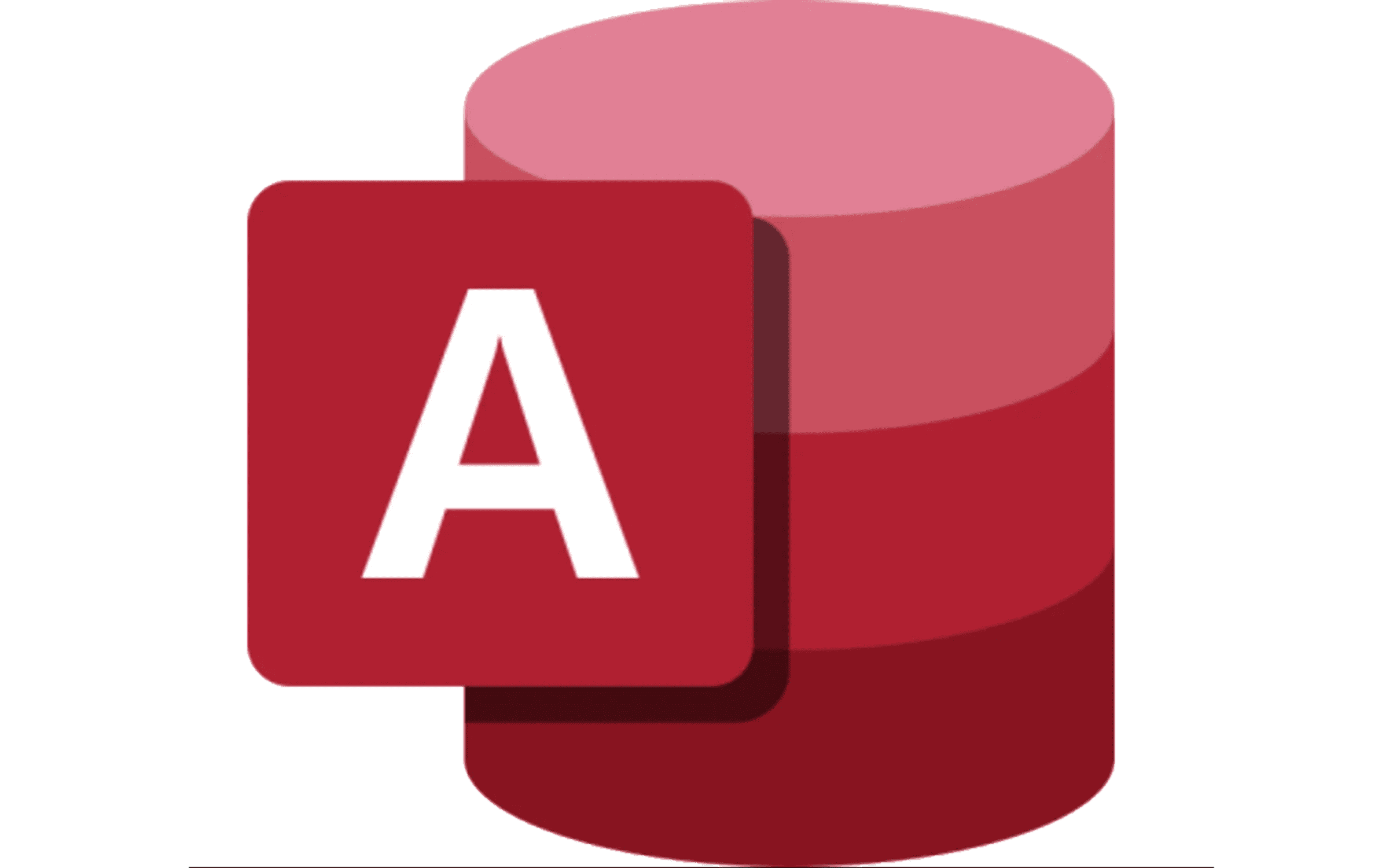
Microsoft office access - agree
Microsoft Access: Is it still relevant in 2022?

Is MS Access still used? Some history
Microsoft Office is almost 30 years old – it was launched in November 1990. Not many software packages have enjoyed such longevity. However, the Microsoft bundle hasn’t stayed the same over the years. Some elements get added, while others get dropped. One component of the productivity suite that is still in there is Microsoft Access.
Access debuted in 1992. Microsoft had struggled to produce a desktop DBMS for years and fast-tracked the development process by buying up one of the sector’s market leaders, FoxPro. Although Microsoft continued to market and develop FoxPro, it was able to pick at some of the code and services of its new acquisition to bump-start its own database engine project. The transfusion was successful.
Access rode on the success of Windows. The package’s main rivals failed to spot the rise in this operating system and didn’t release Windows versions fast enough. Microsoft also killed off FoxPro to make room in the market for MS Access. The success of the tool increased when it was included in Microsoft Office in 1995.
The tool then became part of the Microsoft Office evolutionary pipeline with a requirement to get overhauled regularly in synchronization with the development of other Office components. This really took Access to the next level.
Microsoft Access Database deployment and issues
One problem with Microsoft Access is that it has its own file format that isn’t compatible with any other system. While Microsoft adopted an OpenDocument Format-compatible XML-based file structure for Excel and Word, it left the old file structure of Access alone.
The .docx and .xmlx file formats of Word and Excel have become the universal touchstone of file types in their respective application fields. However, the .accdb format used by Access never caught the public’s imagination and other developers of rival productivity suites weren’t interested in building Access file compatibility into their desktop database applications.
A common use of Microsoft Access is to keep it as a front end to more commercially successful DBMSs. For example, Access can attach to an Oracle database, so business applications written in Access can connect through to data held in an Oracle database. Access can also front for SQL Server and Sybase. However, this repurposing of the Access application feels a little like a half-life. Is this the last resort for Access, acting as a skin to more successful RDBMSs?
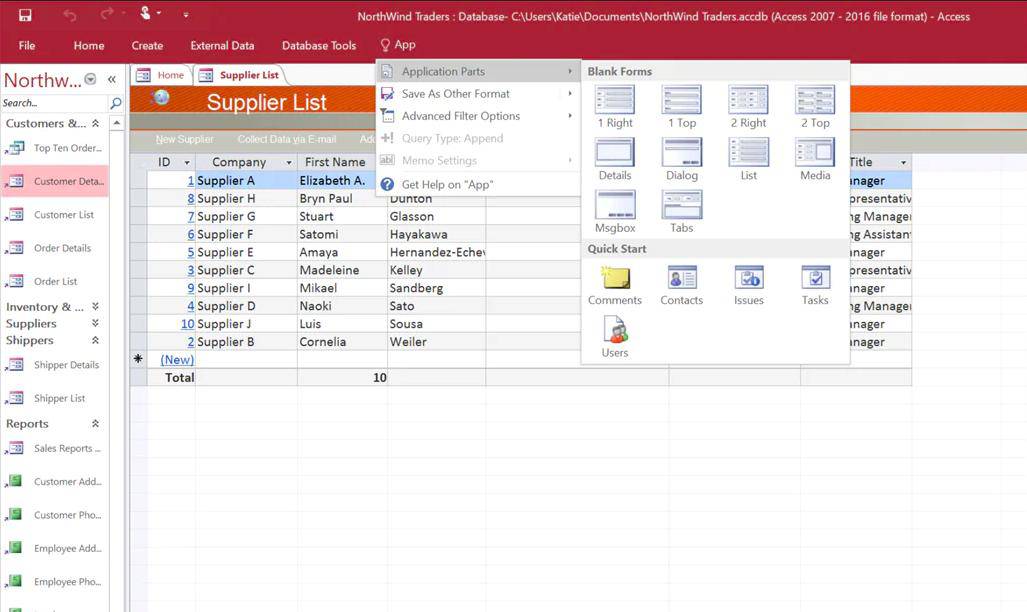
As the demand for Access programming language skills lessens, fewer programmers bother to learn the system. This begins a cycle of decline where the lack of an available developer skills pool puts project managers off from using an environment to develop a new product. So, the shortage of programmers with data management skills creates a shortage of projects in that language and the lack of demand for those skills makes mastering that language a poor career move. Thus, the skills pool shrinks further and the cycle of decline continues. Microsoft Access could be following COBOL, FoxPro, and SQLBase down the path to oblivion.
MS Access faced an uncertain future
Microsoft couldn’t help but notice the meteoric fall of Access from its heights as the most widely used desktop database system in 2011 to being an embarrassing left-over in 2017. The company announced in November 2017, close to the application’s 25th birthday, that it intended to retire Microsoft Access from its online productivity suite.
The official shutdown date for Access Web Apps and Web Databases in Office 365 was set for April 2018. Despite declaring the removal of Access from Office 365, Microsoft quietly changed its mind. Updates continued to appear – the latest version of Access in Office 365 was released in September 2020. Also, Microsoft continued to develop the desktop database software, releasing Access 2019 in September 2018 as part of Office 2019. Microsoft has a page where you can check which version of MS Access you are using. Depending on the version of Access you have deployed, you can check on updates and new features as well.
The lingering purpose of Access lies in the self-build market. However, what small business operator will bother creating a contacts database in Access or setting up an invoice form when there are plenty of ready-made invoice generators available on the web? Who is going to create a recipe database for the kitchen when plenty of online cooking sites already make those recipes available anytime on-demand?
The Best Microsoft Access Alternatives
Think of a situation where someone might still need to use Access and just as quickly, you can come up with a better alternative that is already available. If you can’t, we’ve come up with a shortlist of alternatives to Microsoft Access.
1. OpenOffice derivatives
OpenOffice presented a serious challenge to Microsoft Office. It contained all of the elements anyone wanted from Microsoft Office but was free. Microsoft toughed it out and finally, the free OpenOffice failed to provide enough investment to keep it up to date. The bugs in the system eventually made it a security risk and the free alternative to Office withered.
OpenOffice still exists today, though, as an open-source project, its code was available and a lot of people made their own versions. In most cases, the “forks” of OpenOffice used the same component names for the individual applications in the suite. The OpenOffice equivalent of Access is called Base. Base has its own file format — .odb – and it isn’t able to open .accdb files created in Access. Base isn’t any better than Access, except that it is free. There are still versions of OpenOffice available for free.
Pros:
- Completely free and open-source software
- Includes similar tools you’d find in the paid version of Microsoft Office
Cons:
- User interface feels outdated and clunky, especially when compared to options like Google Docs
- The timeline for bug fixes is completely dependent on the open-source community
- Base is not compatible with .accdb files, meaning you can’t work cross-platform
Apache OpenOffice
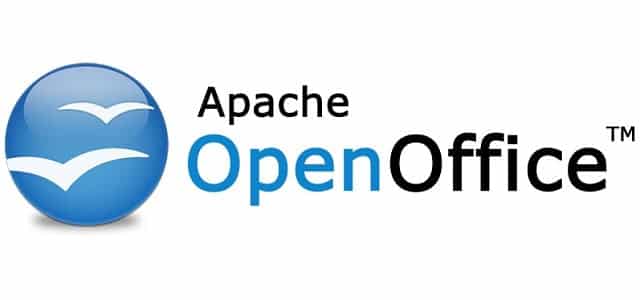
The original OpenOffice got foisted off on the Apache Foundation. The Foundation initially got some support from IBM who lent the project to a development team that rewrote it to be the same and IBM’s Lotus Symphony. Since IBM withdrew, the project has shriveled. Base is still a component of Apache OpenOffice and it is completely free to use.
2021 Update: Despite having a lower development budget since the departure of IBM, Apache is still maintaining the code for this suite. There were three update releases during 2021, so the system is still being kept fresh.
Pros:
- Slightly better interface than OpenOffice
- Completely free to use
- Relatively stable, making it a solid alternative to Microsoft Access for smaller offices
Cons:
- Is borderline abandonware, and is no longer supported by the developer community
- Lacks cloud storage backups
LibreOffice
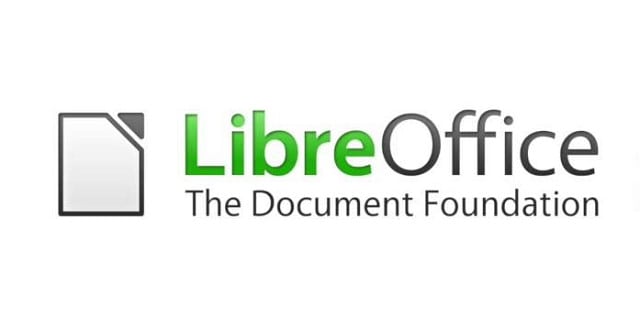
LibreOffice is a clone of OpenOffice and ended up being more successful. The suite includes Base, which is a good free alternative to Microsoft Access. It has its latest versions for Windows, Mac OS, Linux, and Android.
Pros:
- Available for Windows, Mac, Linux, and even Android
- Completely free
- Simple interface that gets the job done
Cons:
- Essentially a clone of OpenOffice with minor improvements
- Lacks cloud storage support and automatic backups
OxygenOffice Professional

OxygenOffice Professional is a free, open-source clone of OpenOffice, which claims to be compatible with the original, Apache run version of the suite and offers extra templates and fonts. However, the code for OxygenOffice Professional hasn’t been updated since May 2013, which means it is seriously out of date.
2. Google Forms
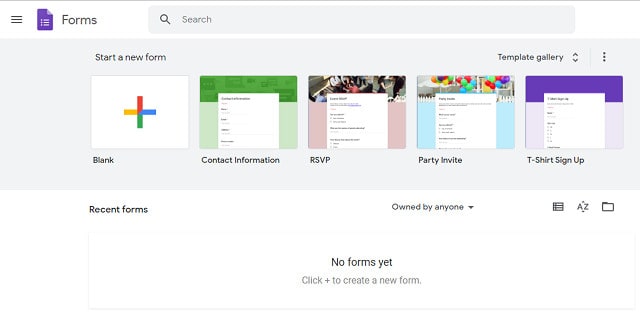
Google G -Suite is a powerful rival to Office 365. The free version is just called Google Docs even though it contains more than the eponymous word processor. Google Forms is part of the suite. You can use Google Forms to create data entry and data query screens and use Google Sheets (a spreadsheet) as the back-end database.
The interface of Google Forms is very easy to use and anyone can create a small database application without any technical knowledge. Check out this YouTube video on how to create a database with Google tools.
Pros:
- Available for all platforms, and accessible through nearly all browsers
- Supports cloud storage and Work Offline
- Feature numerous helpful templates
- Is arguable easier to learn and use than Excel, especially when it comes to creating formulas
- One of the best interfaces among similar tools
Cons:
- Some features like Work Offline are only available via Chrome browser
- Google is not the most privacy-focused company and may sell your data as a part of their business model
3. Calligra Office

KDE produces Calligra Office, an open-source project that is free to use. The database system in Calligra Office is called Kexi. It uses the OpenDocument format, .odb as its native file type. Calligra Office installs on Windows, Mac OS, Linux, and BSD Unix.
Pros:
- Open-source transparent software
- The database utilizes the .odb file type, which is a universal standard that works with many cross-platform tools
- Available for Windows, Mac, Linux, and BSD Unix
Cons:
- Antiquated user interface looks like it’s from Windows NT
- Lacks automatic backup or cloud storage options
4. Zoho Creator
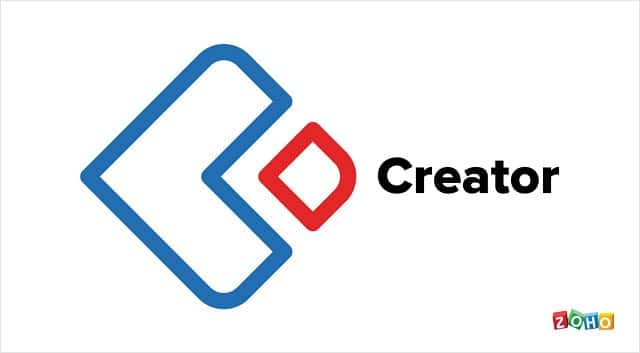
Zoho Creator is an online application creation environment that is based around the development of Access-like databases. The development environment includes a guide, with staged tasks that help you create a database and screens and reports based on it. This is a professional solution, however, there is also a free tier. The two paid plans are charged for by subscription. You can assess the paid editions of Zoho Creator with a 15-day free trial.
2021 Update: There is now also a freeware version – See the price comparisons.
Pros:
- Has one of the best user interfaces, comparable to Google Drive
- Cloud-based hosting allows for automatic backups and offline working
- Subscription pricing makes it a flexible option for nearly any size team
Cons:
- Would like to see a longer trial period for testing
- Lacks in-depth user management features that would be critical for large enterprises
5. Bubble

Bubble is a good alternative for those who use Access to interface to other DBMSs. This is a codeless website development tool with the ability to create data forms for data entry and query. The company offers a hosting service as well. You can design a site or a page and host it on the Bubble servers, setting up new databases or linking back to your existing databases.
This is a paid service but there is a free version. The free Bubble will have “Built with Bubble” printed on your page.
Pros:
- Has both freeware and paid options available
- Interface is barebones but easy to learn with a bit of time
- Offers data hosting as an option
Cons:
- Lacks user management features for larger teams
- Could use more/better team related features for collaboration
Users’ Recommendations
This article has attracted a lot of community attention with a number of commenters recommending alternative packages to Microsoft Access. We list the most common ones here:
- Claris FileMaker This tool is provided by a division of Apple and it provides a database system with a GUI front-end that enables entire apps and Web pages to be constructed from a database design. Claris also offers a consultancy service to design solutions. Design is implemented through templates and a drag-and-drop visual editor with add-ons that provide features and functions. Runs on Windows and macOS and is available for a 45-day free trial.
- Wisej This rapid development framework provides all of the elements you need to create a front-end plus all back-end services for a new application or website. The design tool is based on Visual Studio and you can write code in C# and VB.NET. However, the designer includes widgets that let you place element icons on a design layout and define their behavior through properties, which makes creating systems very easy. There is a free version available and the paid editions are available for a 30-day free trial. Runs on Windows.
- Microsoft Power Platform (Power Apps) Touted as Microsoft’s replacement for Access, this suite of app development, business intelligence, and connectivity tools enables developers to create complicated applications for Web deployment through a coordinated suite of tools, such as Power BI, which operates as an ERP. The core development tool in the package is Power Apps which enables the creation of front-ends and linked back-end systems, such as databases with almost no programming requirements. The Power Apps environment installs on Windows and you can get it for a 30-day free trial.
- Airtable This cloud-based development system creates business systems that are based on a data management system that is a cross between a spreadsheet and a database. You design a data structure and then produce a form as a front-end to it. Rather than using this system for a website, you would create presentations on operational data, marketing campaign trackers, recruitment management interfaces, or project management systems with this service. You can access the system on a 14-day free trial.
- Monday.com This is an application development suite that is hosted on the cloud. Users of this system create team management, project management, collaboration utilities, and Web applications with the environment without needing to write any code. This is a visual editing service, supported by templates, that constructs back-end supporting structures, such as data storage services to match the requirements of the application under development. Finished screens for the service can integrate media panels and generate reports in a range of formats, including PDF. You can try out Monday.com with a 14-day free trial.
Should you leave Access behind?
If you were depressed about the decline of Microsoft Access, then hopefully, this review of the status of the package and alternatives to it has given you some cheer. The way forward out of your Access depression is to try out some other database systems.
The free alternatives on this list show you that you shouldn’t have paid for Access in the first place. One problem you will face is migrating your data out of the .accdb format. However, you can export data in CSV format and import that into a new database created with any DBMS.
Microsoft Access FAQs
What is replacing Microsoft Access?
Microsoft doesn’t have any plans to replace Microsoft Access while also planning to remove the application from Office 365. Therefore, Access users will need to look at alternative systems to run their desktop databases, such as LibreOffice Base, Zoho Creator, or Bubble.
What is the difference between SQL and Microsoft Access?
SQL stands for “structured query language.” It is a generic language, originally invented by IBM, for accessing data in relational databases. Since the creation of SQL in the early 1970s, several proprietary adaptations have been formulated. Microsoft Access uses a version of SQL that is very close to the original, definitive language.
Is Visual Basic still used today?
Visual Basic went through a transformation in 2002 when it was integrated into the .NET framework. For a while, it was called Visual Basic .NET (or VB.NET) but now has gone back to the Visual Basic name. Visual Basic is still supported by Microsoft and is still being developed. The latest version is Visual Basic 2019, which is also referred to as VB 16.0. This is sold as part of the Visual Studio 2019 package.
Does Google have a version of Microsoft Access?
The closest Google Cloud has to Access is Google Bigtable, a NoSQL big data system. This is not included in G-Suite.
Is Microsoft Access going away?
The current status is that Microsoft is fully committed to continuing development and support of Microsoft Access.
Does Office 365 include Microsoft Access?
Microsoft Access is part of the Microsoft 365 Office Suite for Microsoft 365 Family, Microsoft 365 Personal, Microsoft 365 Apps for Business, and Microsoft 365 Business Standard.
Microsoft Office 365 Access Basic to Intermediate
Prerequisites
None. This course is also suitable for leaners of Microsoft Office 2016, 2019 or 2021.
Important Note
Must read Things You Would Need to ensure you are properly equiped for this course.
Jump Start your Office 365 Access in the Data-Driven Age
In today’s Data-Driven economy there is much more reliance on data and getting the right and accurate reports quickly. The volume of data is growing exponentially, and changes are rapidly and frequent. Reliance on Microsoft Excel is not ideal nor efficient in handling huge volumes of data. This is where Office 365 Access will more adequately meet such demands and dynamic changes to bring your productivity and efficiency higher.
This Microsoft Office 365 Access Basic to Intermediate course will equip you to:
- Plan and design a database correctly to meet today’s dynamic challenges. Gone are the days where you can just throw everything into a single table.
- Understand the different data types available in Office 365 Access and select the most suitable data type to use for the different kinds of data. Choosing the wrong data type can adversely affect your data retrieval and reports accuracy.
- Establish relationships in your Office 365 Access database to link and associate data between tables. If this is not correctly done, information that belongs to a customer that is stored in a different table cannot be retrieved or retrieved correctly.
- Easily create and edit data in an Office 365 Access database.
- Extract out (Export) data from your Access database to be used outside of Microsoft Office 365 Access or add in (Import) data from another source (eg. a text file) into your existing Access tables.
- Create a form quickly and directly from Office 365 Access to handle your data records.
- Generate reports straight out of Microsoft Access easily.
This Office 365 Access Basic to Intermediate level course incorporates a mini workshop in how to correctly build your Microsoft Access tables so that you will understand how many tables are needed, how and why which data goes into which of the table. Getting this wrong, greatly increases errors and inaccuracies in your data retrieval and reports that could be detrimental in this data-driven age.
Besides the mini workshop, in this 2-day course you will be given many practice opportunities through rote learning (hands-on exercises) to ensure you get the most out of our Office 365 Access Basic to Intermediate course.
Our Friendly Trainer
Ms Daphne Wong
Ms Kendra Ong
Ms Pauline Lee
Ms Ow Yeong Yin Leng
Qualified and Experienced to facilitate this course
- More than 20 years of training experience
- Native speaking Trainers
- ACTA Certified
- Microsoft Certified
- ITE Certified
Special Request
Additional Dates: If the dates listed are not suitable for you and you have a group interested in the same course, you can contact us to arrange a date of your choice, subject to our trainer availability.
Evening classes or Classes in Mandarin are also available on request. Contact us for arrangements.
Group discounts are also available. Request a quote from us.
Reviews
Trainer is patient and willing to track back to assist trainee.
- Chin Kok Koh (Voice of Hope Pte Ltd)I benefited a lot as I have little access knowledge.
- Johannes Asmira (MOF)
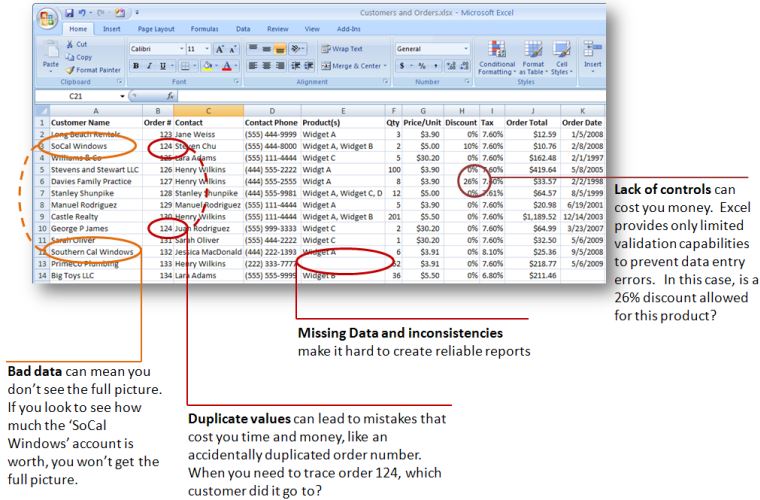
- Fewer errors and inconsistencies. Maintaining one version of the truth for the things you need to track minimizes the potential for duplication, errors, and inconsistent values. In the Excel example above, customer names, contact phone numbers, and product names are misspelled, transposed, and abbreviated in different forms. Imagine trying to create a report or graph in Excel that shows an accurate picture of your sales or other key performance indicators.
- Higher productivity. You and others working in your database need only change a single record and all other related things in your database will automatically "see" the change. In our Excel example, you would need to change every occurrence of a customer's name. Find and replace wouldn't necessarily catch that a customer's name is spelled six different ways. In a database, there is only one customer record to change. Every other record (orders, contacts, etc) that relates to that customer record will never need to change because they are joined to the customer.
- Security and Control. Databases provide a central location to store, secure, and control your data. Microsoft Access includes the ability to encrypt and password protect database files. And with users relying on a database rather than separate Excel spreadsheets, you can have greater control over access to the information.
- Better Decisions and Insight. Perhaps most importantly, a single source of truth in a standardized format means you can gain better insight and make better decisions by reporting and analyzing your data in a database. Users are familiar with Excel charting, and databases like Microsoft Access can provide similar capabilities, while going beyond Excel with more powerful historical trending, aggregation, and query filtering.
Microsoft Access works in the same manner any database does, by storing related information together, and letting you create connections (commonly called relationships) between different things. The relationships between two different things in MSAccess can be very simple (such as a contact at a customer and the customer itself) or complex. In the example below, the blue boxes represent the major things we're tracking in our MS Access database tables, and the reports at right show how you can join the related information for analysis and reporting.
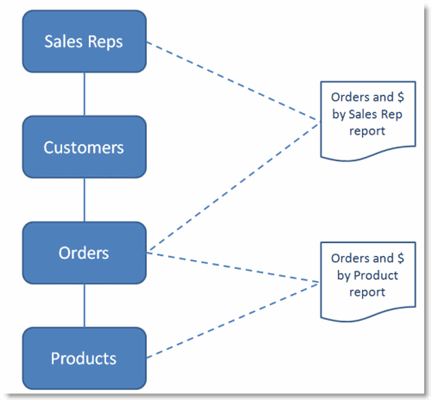
Data is stored in Microsoft Access tables (think of them as mini-spreadsheets that store only one type of thing). A table can have many fields (think of them as columns in your spreadsheet). Each field in a table can be set up to allow or prevent users from entering certain information (for example, you could say one field only accepts dates, another can only allow a user to enter a numeric value, while another lets them enter anything they want).
Once you have your MS Access tables, fields, and relationships set up, you can create data entry forms that use those tables to store your information and later create reports with the data. Microsoft Access forms are incredibly easy (and fun) to design with a wysiwyg form design tool. And you can use MS Access forms to simplify data entry for users by grouping related fields together, and hiding fields they don't need to enter. The Microsoft Access Command Button Wizard even helps you to create simple buttons for your forms without understanding how to create macros and Visual Basic.Register for our free eBook - 'Using Microsoft Access For Greater Efficiency' where you can get a comprehensive view of how Microsoft Access can help you be more productive, when to choose Access as a solution, best practices, and where to get help online.
Microsoft Access
Database manager part of the Microsoft Office package
Microsoft Access is a database management system (DBMS) from Microsoft that combines the relationalAccess Database Engine (ACE) with a graphical user interface and software-development tools (not to be confused with the old Microsoft Access which was a telecommunication program that provided terminal emulation and interfaces for ease of use in accessing online services such as Dow Jones, Compuserve and electronic mailbox back during 1980s[3][4]). It is a member of the Microsoft 365 suite of applications, included in the Professional and higher editions or sold separately.
Microsoft Access stores data in its own format based on the Access Database Engine (formerly Jet Database Engine). It can also import or link directly to data stored in other applications and databases.[5]
Software developers, data architects and power users can use Microsoft Access to develop application software. Like other Microsoft Office applications, Access is supported by Visual Basic for Applications (VBA), an object-based programming language that can reference a variety of objects including the legacy DAO (Data Access Objects), ActiveX Data Objects, and many other ActiveX components. Visual objects used in forms and reports expose their methods and properties in the VBA programming environment, and VBA code modules may declare and call Windows operating system operations.
History[edit]
Prior to the introduction of Access, Borland (with Paradox and dBase) and Fox (with FoxPro) dominated the desktop database market. Microsoft Access was the first mass-market database program for Windows. With Microsoft's purchase of FoxPro in 1992 and the incorporation of Fox's Rushmore query optimization routines into Access, Microsoft Access quickly became the dominant database for Windows—effectively eliminating the competition which failed to transition from the MS-DOS world.[6]
Project Omega[edit]
Microsoft's first attempt to sell a relational database product was during the mid 1980s, when Microsoft obtained the license to sell R:Base.[7] In the late 1980s Microsoft developed its own solution codenamed Omega.[8] It was confirmed in 1988 that a database product for Windows and OS/2 was in development.[9][10] It was going to include the "EB" Embedded Basic language,[8] which was going to be the language for writing macros in all Microsoft applications,[11] but the unification of macro languages did not happen until the introduction of Visual Basic for Applications (VBA). Omega was also expected to provide a front end to the Microsoft SQL Server.[12] The application was very resource-hungry, and there were reports that it was working slowly on the 386 processors that were available at the time.[13] It was scheduled to be released in the 1st quarter of 1990,[14] but in 1989 the development of the product was reset[7][15] and it was rescheduled to be delivered no sooner than in January 1991.[16] Parts of the project were later used for other Microsoft projects: Cirrus (codename for Access) and Thunder (codename for Visual Basic, where the Embedded Basic engine was used).[7][8] After Access's premiere, the Omega project was demonstrated in 1992 to several journalists and included features that were not available in Access.[17]
Project Cirrus[edit]
After the Omega project was scrapped, some of its developers were assigned to the Cirrus project (most were assigned to the team which created Visual Basic).[7] Its goal was to create a competitor for applications like Paradox or dBase that would work on Windows.[18] After Microsoft acquired FoxPro, there were rumors that the Microsoft project might get replaced with it,[19] but the company decided to develop them in parallel. It was assumed that the project would make use of Extensible Storage Engine (Jet Blue)[20] but, in the end, only support for Jet Database Engine (Jet Red) was provided. The project used some of the code from both the Omega project and a pre-release version of Visual Basic.[8] In July 1992, betas of Cirrus shipped to developers[21] and the name Access became the official name of the product.[22] "Access" was originally used for an older terminal emulation program from Microsoft. Years after the program was abandoned, they decided to reuse the name here.[23]
Timeline[edit]
Microsoft released Access version 1.0 on November 13, 1992, and an Access 1.1 release in May 1993 to improve compatibility with other Microsoft products and to include the Access Basic programming language.
With Access v2.0, Microsoft specified the minimum hardware requirements to be Microsoft Windows v3.1 with 4 MB of RAM required, 6 MB RAM recommended; 8 MB of available hard disk space required, 14 MB hard disk space recommended. The product shipped on seven 1.44 MB diskettes. The manual shows a 1994 copyright date.
As a part of the Microsoft Office 4.3 Professional with Book Shelf, Microsoft Access 2.0 was included with first sample databases "NorthWind Trader" which covered every possible aspect of programming your own database. The Northwind Traders sample first introduced the Main Switchboard features new to Access 2.0 for 1994. The photo of Andrew Fuller, record #2 of that sample database was the individual that presented and worked with Microsoft to provide such an outstanding example database.
With Office 95, Microsoft Access 7.0 (a.k.a. "Access 95") became part of the Microsoft Office Professional Suite, joining Microsoft Excel, Word, and PowerPoint and transitioning from Access Basic to VBA. Since then, Microsoft has released new versions of Microsoft Access with each release of Microsoft Office. This includes Access 97 (version 8.0), Access 2000 (version 9.0), Access 2002 (version 10.0), Access 2003 (version 11.5), Access 2007 (version 12.0), Access 2010 (version 14.0), and Access 2013 (version 15.0).
Versions 3.0 and 3.5 of Jet Database Engine (used by Access 7.0 and the later-released Access 97 respectively) had a critical issue which made these versions of Access unusable on a computer with more than 1 GB of memory.[24] While Microsoft fixed this problem for Jet 3.5/Access 97 post-release, it never fixed the issue with Jet 3.0/Access 95.
The native Access database format (the Jet MDB Database) has also evolved over the years. Formats include Access 1.0, 1.1, 2.0, 7.0, 97, 2000, 2002, and 2007. The most significant transition was from the Access 97 to the Access 2000 format; which is not backward compatible with earlier versions of Access. As of 2011[update] all newer versions of Access support the Access 2000 format. New features were added to the Access 2002 format which can be used by Access 2002, 2003, 2007, and 2010.
Microsoft Access 2000 increased the maximum database size to 2 GB from 1 GB in Access 97.
Microsoft Access 2007 introduced a new database format: ACCDB. It supports links to SharePoint lists and complex data types such as multivalue and attachment fields. These new field types are essentially recordsets in fields and allow the storage of multiple values or files in one field. Microsoft Access 2007 also introduced File Attachment field, which stored data more efficiently than the OLE (Object Linking and Embedding) field.

Microsoft Access 2010 introduced a new version of the ACCDB format supported hosting Access Web services on a SharePoint 2010 server. For the first time, this allowed Access applications to be run without having to install Access on their PC and was the first support of Mac users. Any user on the SharePoint site with sufficient rights could use the Access Web service. A copy of Access was still required for the developer to create the Access Web service, and the desktop version of Access remained part of Access 2010. The Access Web services were not the same as the desktop applications. Automation was only through the macro language (not VBA) which Access automatically converted to JavaScript. The data was no longer in an Access database but SharePoint lists. An Access desktop database could link to the SharePoint data, so hybrid applications were possible so that SharePoint users needing basic views and edits could be supported while the more sophisticated, traditional applications could remain in the desktop Access database.
Microsoft Access 2013 offers traditional Access desktop applications plus a significantly updated SharePoint 2013 web service.[25] The Access Web model in Access 2010 was replaced by a new architecture that stores its data in actual SQL Server databases. Unlike SharePoint lists, this offers true relational database design with referential integrity, scalability, extensibility and performance one would expect from SQL Server.[26] The database solutions that can be created on SharePoint 2013 offer a modern user interface designed to display multiple levels of relationships that can be viewed and edited, along with resizing for different devices and support for touch. The Access 2013 desktop is similar to Access 2010 but several features were discontinued including support for Access Data Projects[clarification needed] (ADPs), pivot tables, pivot charts, Access data collections, source code control, replication, and other legacy features.[27] Access desktop database maximum size remained 2 GB (as it has been since the 2000 version).
Uses[edit]
In addition to using its own database storage file, Microsoft Access also may be used as the 'front-end' of a program while other products act as the 'back-end' tables, such as Microsoft SQL Server and non-Microsoft products such as Oracle and Sybase. Multiple backend sources can be used by a Microsoft Access Jet Database (ACCDB and MDB formats). Similarly, some applications such as Visual Basic, ASP.NET, or Visual Studio .NET will use the Microsoft Access database format for its tables and queries. Microsoft Access may also be part of a more complex solution, where it may be integrated with other technologies such as Microsoft Excel, Microsoft Outlook, Microsoft Word, Microsoft PowerPoint and ActiveX controls.
Access tables support a variety of standard field types, indices, and referential integrity including cascadingupdates and deletes. Access also includes a query interface, forms to display and enter data, and reports for printing. The underlying Access database, which contains these objects, is multi-user and handles record-locking.
Repetitive tasks can be automated through macros with point-and-click options. It is also easy to place a database on a network and have multiple users share and update data without overwriting each other's work. Data is locked at the record level which is significantly different from Excel which locks the entire spreadsheet.
There are template databases within the program and for download from Microsoft's website. These options are available upon starting Access and allow users to enhance a database with predefined tables, queries, forms, reports, and macros. Database templates support VBA code, but Microsoft's templates do not include VBA code.
Programmers can create solutions using VBA, which is similar to Visual Basic 6.0 (VB6) and used throughout the Microsoft Office programs such as Excel, Word, Outlook and PowerPoint. Most VB6 code, including the use of Windows API calls, can be used in VBA. Power users and developers can extend basic end-user solutions to a professional solution with advanced automation, data validation, error trapping, and multi-user support.
The number of simultaneous users that can be supported depends on the amount of data, the tasks being performed, level of use, and application design. Generally accepted limits are solutions with 1 GB or less of data (Access supports up to 2 GB) and it performs quite well with 100 or fewer simultaneous connections (255 concurrent users are supported).[28] This capability is often a good fit for department solutions. If using an Access database solution in a multi-user scenario, the application should be "split". This means that the tables are in one file called the back end (typically stored on a shared network folder) and the application components (forms, reports, queries, code, macros, linked tables) are in another file called the front end. The linked tables in the front end point to the back end file. Each user of the Access application would then receive his or her own copy of the front end file.
Applications that run complex queries or analysis across large datasets would naturally require greater bandwidth and memory. Microsoft Access is designed to scale to support more data and users by linking to multiple Access databases or using a back-end database like Microsoft SQL Server. With the latter design, the amount of data and users can scale to enterprise-level solutions.
Microsoft Access's role in web development prior to version 2010 is limited. User interface features of Access, such as forms and reports, only work in Windows. In versions 2000 through 2003 an Access object type called Data Access Pages created publishable web pages. Data Access Pages are no longer supported. The Jet Database Engine, core to Access, can be accessed through technologies such as ODBC or OLE DB. The data (i.e., tables and queries) can be accessed by web-based applications developed in ASP.NET, PHP, or Java. With the use of Microsoft's Terminal Services and Remote Desktop Application in Windows Server 2008 R2, organizations can host Access applications so they can be run over the web.[29] This technique does not scale the way a web application would but is appropriate for a limited number of users depending on the configuration of the host.
Access 2010 allows databases to be published to SharePoint 2010 web sites running Access Services. These web-based forms and reports run in any modern web browser. The resulting web forms and reports, when accessed via a web browser, don't require any add-ins or extensions (e.g., ActiveX and Silverlight).
Access 2013 can create web applications directly in SharePoint 2013 sites running Access Services. Access 2013 web solutions store its data in an underlying SQL Server database which is much more scalable and robust than the Access 2010 version which used SharePoint lists to store its data.
Access Services in SharePoint has since been retired.[30]
A compiled version of an Access database (file extensions .MDE /ACCDE or .ADE; ACCDE only works with Access 2007 or later) can be created to prevent users from accessing the design surfaces to modify module code, forms, and reports. An MDE or ADE file is a Microsoft Access database file with all modules compiled and all editable source code removed. Both the .MDE and .ADE versions of an Access database are used when end-user modifications are not allowed or when the application's source code should be kept confidential.
Microsoft also offers developer extensions for download to help distribute Access 2007 applications, create database templates, and integrate source code control with Microsoft Visual SourceSafe.
Features[edit]
Users can create tables, queries, forms and reports, and connect them together with macros. Advanced users can use VBA to write rich solutions with advanced data manipulation and user control. Access also has report creation features that can work with any data source that Access can access.
The original concept of Access was for end users to be able to access data from any source. Other features include: the import and export of data to many formats including Excel, Outlook, ASCII, dBase, Paradox, FoxPro, SQL Server and Oracle. It also has the ability to link to data in its existing location and use it for viewing, querying, editing, and reporting. This allows the existing data to change while ensuring that Access uses the latest data. It can perform heterogeneousjoins between data sets stored across different platforms. Access is often used by people downloading data from enterprise level databases for manipulation, analysis, and reporting locally.
There is also the Access Database (ACE and formerly Jet) format (MDB or ACCDB in Access 2007) which can contain the application and data in one file. This makes it very convenient to distribute the entire application to another user, who can run it in disconnected environments.
One of the benefits of Access from a programmer's perspective is its relative compatibility with SQL (structured query language)—queries can be viewed graphically or edited as SQL statements, and SQL statements can be used directly in Macros and VBA Modules to manipulate Access tables. Users can mix and use both VBA and "Macros" for programming forms and logic and offers object-oriented possibilities. VBA can also be included in queries.
Microsoft Access offers parameterized queries. These queries and Access tables can be referenced from other programs like VB6 and .NET through DAO or ADO. From Microsoft Access, VBA can reference parameterized stored procedures via ADO.
The desktop editions of Microsoft SQL Server can be used with Access as an alternative to the Jet Database Engine. This support started with MSDE (Microsoft SQL Server Desktop Engine), a scaled down version of Microsoft SQL Server 2000, and continues with the SQL Server Express versions of SQL Server 2005 and 2008.
Microsoft Access is a file server-based database. Unlike client–serverrelational database management systems (RDBMS), Microsoft Access does not implement database triggers, stored procedures, or transaction logging. Access 2010 includes table-level triggers and stored procedures built into the ACE data engine. Thus a Client-server database system is not a requirement for using stored procedures or table triggers with Access 2010. Tables, queries, forms, reports and macros can now be developed specifically for web based applications in Access 2010. Integration with Microsoft SharePoint 2010 is also highly improved.
The 2013 edition of Microsoft Access introduced a mostly flat design and the ability to install apps from the Office Store, but it did not introduce new features. The theme was partially updated again for 2016, but no dark theme was created for Access.
Access Services and Web database[edit]
See also: Web form
ASP.NETweb forms can query a Microsoft Access database, retrieve records and display them on the browser.[31]
SharePoint Server 2010 via Access Services allows for Access 2010 databases to be published to SharePoint, thus enabling multiple users to interact with the database application from any standards-compliant Web browser. Access Web databases published to SharePoint Server can use standard objects such as tables, queries, forms, macros, and reports. Access Services stores those objects in SharePoint.[32]
Access 2013 offers the ability to publish Access web solutions on SharePoint 2013. Rather than using SharePoint lists as its data source, Access 2013 uses an actual SQL Server database hosted by SharePoint or SQL Azure.[33] This offers a true relational database with referential integrity, scalability, maintainability, and extensibility compared to the SharePoint views Access 2010 used. The macro language is enhanced to support more sophisticated programming logic and database level automation.[26]
Import or link sources[edit]
Microsoft Access can also import or link directly to data stored in other applications and databases.[5] Microsoft Office Access 2007 and newer can import from or link to:
Microsoft Access Runtime[edit]
Microsoft offers free runtime versions of Microsoft Access which allow users to run an Access desktop application without needing to purchase or install a retail version of Microsoft Access. This actually allows Access developers to create databases that can be freely distributed to an unlimited number of end-users. These runtime versions of Access 2007 and later can be downloaded for free from Microsoft.[36] The runtime versions for Access 2003 and earlier were part of the Office Developer Extensions/Toolkit and required a separate purchase.
The runtime version allows users to view, edit and delete data, along with running queries, forms, reports, macros and VBA module code. The runtime version does not allow users to change the design of Microsoft Access tables, queries, forms, reports, macros or module code. The runtime versions are similar to their corresponding full version of Access and usually compatible with earlier versions; for example Access Runtime 2010 allows a user to run an Access application made with the 2010 version as well as 2007 through 2000. Due to deprecated features in Access 2013, its runtime version is also unable to support those older features. During development one can simulate the runtime environment from the fully functional version by using the command line option.[37]
Development[edit]
Access stores all database tables, queries, forms, reports, macros, and modules in the Access Jet database as a single file.
For query development, Access offers a "Query Designer", a graphical user interface that allows users to build queries without knowledge of structured query language. In the Query Designer, users can "show" the datasources of the query (which can be tables or queries) and select the fields they want returned by clicking and dragging them into the grid. One can set up joins by clicking and dragging fields in tables to fields in other tables. Access allows users to view and manipulate the SQL code if desired. Any Access table, including linked tables from different data sources, can be used in a query.
Access also supports the creation of "pass-through queries". These snippets of SQL code can address external data sources through the use of ODBC connections on the local machine. This enables users to interact with data stored outside the Access program without using linked tables or Jet.[38] Users construct the pass-through queries using the SQL syntax supported by the external data source.
When developing reports (in "Design View") additions or changes to controls cause any linked queries to execute in the background and the designer is forced to wait for records to be returned before being able to make another change. This feature cannot be turned off.
Non-programmers can use the macro feature to automate simple tasks through a series of drop-down selections. Macros allow users to easily chain commands together such as running queries, importing or exporting data, opening and closing forms, previewing and printing reports, etc. Macros support basic logic (IF-conditions) and the ability to call other macros. Macros can also contain sub-macros which are similar to subroutines. In Access 2007, enhanced macros included error-handling and support for temporary variables. Access 2007 also introduced embedded macros that are essentially properties of an object's event. This eliminated the need to store macros as individual objects. However, macros were limited in their functionality by a lack of programming loops and advanced coding logic until Access 2013. With significant further enhancements introduced in Access 2013, the capabilities of macros became fully comparable to VBA. They made feature rich web-based application deployments practical, via a greatly enhanced Microsoft SharePoint interface and tools, as well as on traditional Windows desktops.
In common with other products in the Microsoft Office suite, the other programming language used in Access is Microsoft VBA. It is similar to Visual Basic 6.0 (VB6) and code can be stored in modules, classes, and code behind forms and reports. To create a richer, more efficient and maintainable finished product with good error handling, most professional Access applications are developed using the VBA programming language rather than macros, except where web deployment is a business requirement.
To manipulate data in tables and queries in VBA or macros, Microsoft provides two database access libraries of COM components:
- Data Access Objects (DAO) (32-bit only), which is included in Access and Windows and evolved to ACE in Microsoft Access 2007 for the ACCDE database format
- ActiveX Data Objects ActiveX Data Objects (ADO) (both 32-bit and 64-bit versions)
As well as DAO and ADO, developers can also use OLE DB and ODBC for developing native C/C++ programs for Access.[39] For ADPs and the direct manipulation of SQL Server data, ADO is required. DAO is most appropriate for managing data in Access/Jet databases, and the only way to manipulate the complex field types in ACCDB tables.
In the database container or navigation pane in Access 2007 and later versions, the system automatically categorizes each object by type (e.g., table, query, macro). Many Access developers use the Leszynski naming convention, though this is not universal; it is a programming convention, not a DBMS-enforced rule.[40][41] It is particularly helpful in VBA where references to object names may not indicate its data type (e.g. tbl for tables, qry for queries).
Developers deploy Microsoft Access most often for individual and workgroup projects (the Access 97 speed characterization was done for 32 users).[42] Since Access 97, and with Access 2003 and 2007, Microsoft Access and hardware have evolved significantly. Databases under 1 GB in size (which can now fit entirely in RAM) and 200 simultaneous users are well within the capabilities of Microsoft Access.[43] Of course, performance depends on the database design and tasks. Disk-intensive work such as complex searching and querying take the most time.
As data from a Microsoft Access database can be cached in RAM, processing speed may substantially improve when there is only a single user or if the data is not changing. In the past, the effect of packet latency on the record-locking system caused Access databases to run slowly on a virtual private network (VPN) or a wide area network (WAN) against a Jet database. As of 2010,[update] broadband connections have mitigated this issue. Performance can also be enhanced if a continuous connection is maintained to the back-end database throughout the session rather than opening and closing it for each table access.[citation needed]
In July 2011, Microsoft acknowledged an intermittent query performance problem with all versions of Access and Windows 7 and Windows Server 2008 R2 due to the nature of resource management being vastly different in newer operating systems.[44] This issue severely affects query performance on both Access 2003 and earlier with the Jet Database Engine code, as well as Access 2007 and later with the Access Database Engine (ACE).[44] Microsoft has issued hotfixes KB2553029 for Access 2007 and KB2553116 for Access 2010, but will not fix the issue with Jet 4.0 as it is out of mainstream support.[44]
In earlier versions of Microsoft Access, the ability to distribute applications required the purchase of the Developer Toolkit; in Access 2007, 2010 and Access 2013 the "Runtime Only" version is offered as a free download,[45] making the distribution of royalty-free applications possible on Windows XP, Vista, 7 and Windows 8.x.[46]
Split database architecture[edit]
Microsoft Access applications can adopt a split-database architecture. The single database can be divided into a separate "back-end" file that contains the data tables (shared on a file server) and a "front-end" (containing the application's objects such as queries, forms, reports, macros, and modules). The "front-end" Access application is distributed to each user's desktop and linked to the shared database. Using this approach, each user has a copy of Microsoft Access (or the runtime version) installed on their machine along with their application database. This reduces network traffic since the application is not retrieved for each use. The "front-end" database can still contain local tables for storing a user's settings or temporary data. This split-database design also allows development of the application independent of the data. One disadvantage is that users may make various changes to their own local copy of the application and this makes it hard to manage version control. When a new version is ready, the front-end database is replaced without impacting the data database. Microsoft Access has two built-in utilities, Database Splitter[47] and Linked Table Manager, to facilitate this architecture.
Linked tables in Access use absolute paths rather than relative paths, so the development environment either has to have the same path as the production environment or a "dynamic-linker" routine can be written in VBA.
For very large Access databases, this may have performance issues and a SQL backend should be considered in these circumstances. This is less of an issue if the entire database can fit in the PC's RAM since Access caches data and indexes.
Migration to SQL Server[edit]
Main article: Upsizing (database)
To scale Access applications to enterprise or web solutions, one possible technique involves migrating to Microsoft SQL Server or equivalent server database. A client–server design significantly reduces maintenance and increases security, availability, stability, and transaction logging.
Access 2000 through Access 2010 included a feature called the Upsizing Wizard that allowed users to upgrade their databases to Microsoft SQL Server, an ODBC client–server database. This feature was removed from Access 2013. An additional solution, the SQL Server Migration Assistant for Access (SSMA), continues to be available for free download from Microsoft.[48]
A variety of upgrading options are available.[49] After migrating the data and queries to SQL Server, the Access database can be linked to the SQL database. However, certain data types are problematic, most notably "Yes/No". In Microsoft Access there are three states for the Yes/No (True/False) data type: empty, no/false (zero) and yes/true (-1). The corresponding SQL Server data type is binary, with only two states, permissible values, zero and 1. Regardless, SQL Server is still the easiest migration. Retrieving data from linked tables is optimized to just the records needed, but this scenario may operate less efficiently than what would otherwise be optimal for SQL Server. For example, in instances where multi-table joins still require copying the whole table across the network.
In previous versions of Access, including Access 2010, databases can also be converted to Access Data Projects (ADP) which are tied directly to one SQL Server database. This feature was removed from Access 2013. ADP's support the ability to directly create and modify SQL Server objects such as tables, views, stored procedures, and SQL Server constraints. The views and stored procedures can significantly reduce the network traffic for multi-table joins. SQL Server supports temporary tables and links to other data sources beyond the single SQL Server database.
Finally, some Access databases are completely replaced by another technology such as ASP.NET or Java once the data is converted. However any migration may dictate major effort since the Access SQL language is a more powerful superset of standard SQL. Further, Access application procedures, whether VBA and macros, are written at a relatively higher level versus the currently available alternatives that are both robust and comprehensive. Note that the Access macro language, allowing an even higher level of abstraction than VBA, was significantly enhanced in Access 2010 and again in Access 2013.
In many cases, developers build direct web-to-data interfaces using ASP.NET, while keeping major business automation processes, administrative and reporting functions that don't need to be distributed to everyone in Access for information workers to maintain.
While all Access data can migrate to SQL Server directly, some queries cannot migrate successfully. In some situations, you may need to translate VBA functions and user defined functions into T–SQL or .NET functions / procedures. Crosstab queries can be migrated to SQL Server using the PIVOT command.
Protection[edit]
Microsoft Access applications can be made secure by various methods, the most basic being password access control; this is a relatively weak form of protection.
A higher level of protection is the use of workgroup security requiring a user name and password. Users and groups can be specified along with their rights at the object type or individual object level. This can be used to specify people with read-only or data entry rights but may be challenging to specify. A separate workgroup security file contains the settings which can be used to manage multiple databases. Workgroup security is not supported in the Access 2007 and Access 2010 ACCDB database format, although Access 2007 and Access 2010 still support it for MDB databases.
Databases can also be encrypted. The ACCDB format offers significantly advanced encryption from previous versions.[50]
Additionally, if the database design needs to be secured to prevent changes, Access databases can be locked/protected (and the source code compiled) by converting the database to a .MDE file. All changes to the VBA project (modules, forms, or reports) need to be made to the original MDB and then reconverted to MDE. In Access 2007 and Access 2010, the ACCDB database is converted to an ACCDE file. Some tools are available for unlocking and "decompiling", although certain elements including original VBA comments and formatting are normally irretrievable.
File extensions[edit]
Microsoft Access saves information under the following file formats:
| File format | Extension |
|---|---|
| Access Blank Project Template | .adn |
| Access Database (2007 and later) | .accdb |
| Access Database Runtime (2007 and later) | .accdr |
| Access Database Template (2007 and later) | .accdt |
| Access Add-In (2007 and later) | .accda |
| Access Workgroup, database for user-level security. | .mdw |
| Protected Access Database, with compiled VBA and macros (2007 and later) | .accde |
| Windows Shortcut: Access Macro | .mam |
| Windows Shortcut: Access Query | .maq |
| Windows Shortcut: Access Report | .mar |
| Windows Shortcut: Access Table | .mat |
| Windows Shortcut: Access Form | .maf |
| Access lock files (associated with .accdb) | .laccdb |
| File format | Extension |
|---|---|
| Protected Access Data Project (not supported in 2013) | .ade |
| Access Data Project (not supported in 2013) | .adp |
| Access Database (2003 and earlier) | .mdb |
| Access Database (Pocket Access for Windows CE) | .cdb |
| Access Database, used for addins (Access 2, 95, 97), previously used for workgroups (Access 2) | .mda |
| Access Blank Database Template (2003 and earlier) | .mdn |
| Access | |
| Access (SQL Server) detached database (2000) | .mdf |
| Protected Access Database, with compiled VBA and macros (2003 and earlier) | .mde |
| Access lock files (associated with .mdb) | .ldb |
Versions[edit]
| Version | Version number | Release Date[51] | JET/ACE version | Supported OS | Office suite version |
|---|---|---|---|---|---|
| Access 1.0 | 1.0 | 1992 | 1.0 | Windows 3.0[52] | |
| Access 1.1 | 1.1 | 1993 | 1.1 | Windows 3.1x[52] | |
| Access 2.0 | 2.0 | 1994 | 2.0 | Windows 3.1x[52] | Office 4.3 Pro |
| Access for Windows 95 | 7.0 | August 24, 1995 | 3.0 | Windows 95[52] | Office 95 Professional |
| Access 97 | 8.0 | January 16, 1997 | 3.5 | Windows 95, Windows NT 3.51 SP5, Windows NT 4.0 SP2[53] | Office 97 Professional and Developer |
| Access 2000 | 9.0 | June 7, 1999 | 4.0 SP1 | Windows 95, Windows NT 4.0, Windows 98, Windows 2000[54] | Office 2000 Professional, Premium and Developer |
| Access 2002 | 10.0 | May 31, 2001 | Windows NT 4.0 SP6, Windows 98, Windows 2000, Windows Me[55] | Office XP Professional and Developer | |
| Access 2003 | 11.0 | November 27, 2003 | Windows 2000 SP3 or later, Windows XP, Windows Vista, Windows 7[56] | Office 2003 Professional and Professional Enterprise | |
| Access 2007 | 12.0 | January 27, 2007 | 12 | Windows XP SP2, Windows Server 2003 SP1, or newer operating system[57] | Office 2007 Professional, Professional Plus, Ultimate and Enterprise |
| Access 2010 | 14.0 | July 15, 2010 | 14 | Windows XP SP3, Windows Server 2003 SP2, Windows Server 2003 R2, Windows Vista SP1, Windows Server 2008, Windows 7, Windows Server 2008 R2, Windows Server 2012, Windows 8[58] | Office 2010 Professional, Professional Academic and Professional Plus |
| Access 2013 | 15.0 | January 29, 2013 | 15 | Windows 7, Windows Server 2008 R2, Windows Server 2012, Windows 8, Windows 10[59] | Office 2013 Professional and Professional Plus |
| Access 2016 | 16.0 | September 22, 2015 | 16 | Windows 7, Windows 8, Windows 8.1, Windows 10[60] | Office 2016 Professional and Professional Plus |
| Access 2019 | September 24, 2018 | Windows 10[61] | Office 2019 Professional and Professional Plus |
There are no Access versions between 2.0 and 7.0 because the Office 95 version was launched with Word 7. All of the Office 95 products have OLE 2 capabilities, and Access 7 shows that it was compatible with Word 7.
Version number 13 was skipped.
See also[edit]
References[edit]
- ^Warren, Tom. "Microsoft Office 2021 will launch on October 5th". The Verge. Retrieved October 5, 2021.
- ^"C++ in MS Office". cppcon. July 17, 2014. Archived from the original on November 7, 2019. Retrieved June 25, 2019.
- ^Inc, Ziff Davis (October 15, 1985). PC Mag. Ziff Davis, Inc.
- ^"Microsoft Access Business Information Access Program 1.0x". WinWorld. Retrieved May 23, 2022.
- ^ ab"Introduction to importing and exporting data". Microsoft. Retrieved October 15, 2010.
- ^"Microsoft Access History". Retrieved March 13, 2016.
- ^ abcdGoodhew, Tony (1996). "Jet Engine: History". Retrieved January 2, 2011.
- ^ abcdFerguson, Scott. "The Birth of Visual Basic".
- ^Brownstein, Mark; Johnston, Stuart J. (November 14, 1988). "Microsoft Works on SAA Database". InfoWorld. p. 5.
- ^Brownstein, Mark (February 13, 1989). "Microsoft Puts Finishing Touches on Windows Applications". InfoWorld. p. 5.
- ^Flynn, Laurie (May 8, 1989). "Microsoft Applications to Share Macro Language". InfoWorld. p. 1.
- ^Flynn, Laurie (August 21, 1989). "Microsoft Waits on SQL Front Ends". InfoWorld. p. 109.
- ^Cringely, Robert X. (September 4, 1989). "Gates Claims That 80286 Systems Are No Longer His Babies". InfoWorld. p. 82.
- ^Cringely, Robert X. (July 31, 1989). "No Way, the PC Industry Will Always Be Dominated By Doritos". InfoWorld. p. 86.
- ^Cringely, Robert X. (October 16, 1989). "Lotus Exec Tells of Ordeal: "Aliens Force Me to Use MS Windows"". InfoWorld. p. 106.
- ^Cringely, Robert X. (November 20, 1989). "Elvis, Now a Vegas Parking Lot Attendant, Further Delays Intel 486". InfoWorld. p. 106.
- ^Mace, Scott (November 30, 1992). "Microsoft demos its ill-fated Omega". InfoWorld. p. 16.
- ^Picarille, Lisa; Mace, Scott (March 30, 1992). "Microsoft's Fox purchase stirs up the XBase market". InfoWorld. p. 1.
- ^Cringely, Robert X. (November 4, 1991). "Whatever costume Eckhard wears is likely to scare Silicon Graphics". InfoWorld. p. 118.
- ^Mace, Scott (June 29, 1992). "Microsoft creating API to complement ODBC". InfoWorld. p. 1.
- ^"Developers get beta version of Microsoft DBMS". InfoWorld. July 13, 1992. p. 3.
- ^Johnston, Stuart J. (July 20, 1998). "Cirrus dubbed Access; faster beta released". InfoWorld. p. 1.
- ^"Where did the name for Microsoft Access come from?". The Old New Thing. Microsoft. April 13, 2006. Retrieved March 13, 2016.
- ^"Out of memory" error starting Microsoft Access
- ^"Changes in Access". Microsoft. Retrieved March 13, 2016.
- ^ ab"New in Access for developers". Microsoft. Retrieved March 13, 2016.
- ^"Discontinued features and modified functionality in Access 2013". Microsoft. Retrieved March 13, 2016.
- ^"Migrate an Access database to SQL Server". support.microsoft.com. Retrieved October 15, 2021.
- ^"Using Terminal Services and RemoteApp to Extend Your Microsoft Access and other Windows Applications Over the Internet". Retrieved March 13, 2016.
- ^"Access Services in SharePoint Roadmap". Microsoft. Retrieved May 20, 2019.
- ^"Create ASP.NET Web Forms to Use a Microsoft Access Database". Retrieved June 13, 2017.
- ^"Creating Web Databases with Access 2010 and Access Services". Msdn.microsoft.com. July 22, 2009. Retrieved April 24, 2013.
- ^"Microsoft Access 2013 Web Applications and Examples". access-templates.com. Retrieved September 4, 2017.
- ^"Back by popular demand—dBASE file support in Access". Office Blogs. Microsoft. September 7, 2016. Retrieved August 20, 2017.
- ^ ab"Discontinued features and modified functionality in Access 2010". Office.com. Microsoft. Retrieved January 17, 2014.
- ^"Microsoft Access Runtime Distribution and Free Downloads". Retrieved June 15, 2016.
- ^"Simulating the Microsoft Access Runtime during Development". Retrieved June 15, 2016.
- ^Sinclair, Russell (2000). From access to SQL server. Apress Series. Apress. p. 39. ISBN . Retrieved July 8, 2010.
- ^Aleksandar Jakšić (August 2008). "Developing Access 2007 Solutions with Native C or C++". Microsoft Corporation. Retrieved September 22, 2008.
- ^"Naming Conventions". Microsoft. Retrieved March 13, 2016.
- ^Naming Conventions for Visual Basic
- ^Kevin Collins (Microsoft Jet Program Management), "Microsoft Jet 3.5 Performance Overview and Optimization Techniques", MSDN. Retrieved July 19, 2005.
- ^"Microsoft Access Database Scalability: How many users can it support?". FMS Software Development Team Blog. Retrieved March 13, 2016.
- ^ abcVery slow Access 2002 query with Windows 7
- ^"Microsoft Access Runtime Distribution Programs and Free Downloads". Retrieved March 13, 2016.
- ^"Download Microsoft Access 2010 Runtime from Official Microsoft Download Center". Microsoft. Retrieved March 13, 2016.
- ^"Microsoft Access Split Database Architecture to Support Multiuser Environments, Improve Performance, and Simplify Maintainability". Fmsinc.com. Retrieved April 24, 2013.
- ^"Microsoft SQL Server Migration Assistant 7.10 for Access". Microsoft.com. Retrieved October 20, 2018.
- ^"When and How to Upsize Microsoft Access Databases to SQL Server". Retrieved March 13, 2016.
- ^"Security Considerations and Guidance for Access 2007". Microsoft. Retrieved March 13, 2016.
- ^"Microsoft Access Life-cycle Information". Retrieved October 23, 2011.
- ^ abcd"Microsoft Access Version Releases, Service Packs, Hotfixes, and Updates History". FMS. Retrieved July 20, 2015.
- ^"Chapter 5 - System Requirements for MS Office". Office 97 Resource Kit. Microsoft. Retrieved May 2, 2013.
- ^"Office 2000 Systems Requirements". Microsoft Office website. Microsoft. Archived from the original on February 2, 2012. Retrieved May 2, 2013.
- ^"Office XP System Requirements". Microsoft Office website. Microsoft. Archived from the original on March 4, 2013. Retrieved May 2, 2013.
- ^"Office 2003 Licensing and System Requirements". Microsoft Office website. Microsoft. Archived from the original on June 15, 2013. Retrieved May 2, 2013.
- ^"Getting started with the 2007 Office system". Microsoft TechNet. Microsoft. April 28, 2009. Retrieved May 2, 2013.
- ^"System requirements for Office 2010". Microsoft TechNet. Microsoft. February 19, 2013. Retrieved May 2, 2013.
- ^"System requirements for Office 2013". Microsoft TechNet. Microsoft. December 16, 2016. Retrieved August 15, 2017.
- ^"Microsoft Access 2016". Microsoft. Microsoft.
- ^"Microsoft Access 2019". Microsoft. Microsoft.
External links[edit]
Elevate data
Integrate with multiple data sources
Integrate data between Access and line-of-business apps using the Access connector library to generate aggregated visuals and insights in the familiar Access interface. Easily store data in SQL Server and Microsoft Azure SQL to enhance reliability, scalability, security, and long-term manageability.*
See more from Microsoft Access
Connect with experts
See what’s new plus get tips and tricks to help you create, customize, and utilize databases like a pro.
Visit the Access Tech Community
Improve your skills
Take your data management skills to the next level with tutorials, documentation, and connections to experts.
Use the Access help center
Follow Microsoft 365
What is Microsoft Access?
Microsoft Access is a Database Management System offered by Microsoft. It uses the Microsoft Jet Database Engine and comes as a part of the Microsoft Office suite of application.
Microsoft Access offers the functionality of a database and the programming capabilities to create easy to navigate screens (forms). It helps you analyze large amounts of information, and manage data efficiently.
Important Terms and Basic Objects
Now in this Microsoft Access tutorial, we will learn about some important terms and basic objects in MS Access:
Database File:
It is a file which stores the entire database. The database file is saved to your hard drive or other storage devices.
Datatypes:
Datatypes are the properties of each field. Every field has one datatype like text, number, date, etc.
Table
- A Table is an object which stores data in Row & Column format to store data.
- A Table is usually related to other tables in the database file.
- Each column must have Unique name
- We can also define Primary Key in a table.
Query
- Queries answer a question by selecting and sorting and filtering data based on search criteria.
- Queries show a selection of data based on criteria (limitations) you provide.
- Queries can pull from one or more related Tables and other Queries.
- Types of Query can be SELECT, INSERT, UPDATE, DELETE.
Form
- A form is a database object that you can use to create a user interface for a database application.
- Forms help you to display live data from the table. It mainly used to ease the process of data entry or editing.
Report
- A report is an object in desktop databases primarily used for formatting, calculating, printing, and summarizing selected data.
- You can even customize the report’s look and feel.
Macros
Macros are mini computer programming constructs. They allow you to set up commands and processes in your forms, like, searching, moving to another record, or running a formula.
Modules:
Modules are procedures(functions) which you can write using Visual Basic for Applications (VBA).
Microsoft Access Data Types
MS Access common data types are listed below:
| Type of Data | Description | Size |
|---|---|---|
| Short Text | Text, including numbers which does not need calculation. (e.g., Mobile numbers). | Up to 255 characters. |
| Long Text | This data type is used for lengthy text or alphanumeric data. | Maximum 63, 999 characters. |
| Number | Numeric data type used for storing mathematical calculations. | 1, 2, 4, 8, and 16 bytes. |
| Date/Time | Store Date/time for the years 100 through 9999. | 8 bytes. |
| Currency | It allows you to store currency values and numeric data with one to four decimal places. | 8 bytes. |
| Auto Number | Assign a unique number or assigned by Microsoft Access when any new record is created. Usually used as the primary key | Four bytes (16 bytes if it is set as a Replication ID). |
| Yes/No | It only stores logical values Yes and No. | 1 bit |
| Attachment | It stores files, such as digital photos. Multiple files can be attached per record. | Up to 2 GB Data can be stored. |
| OLE objects | OLE objects can store audio, video, other Binary Large Objects. | Up to 2 GB data can be stored. |
| Hyperlink | Text or combinations of text and numbers stored. That text is used as hyperlink address. | Each part of a Hyperlink data type allows you to store a maximum 2048 characters. |
| Calculated | Helps you to create an expression that uses data from one or more fields. | You can create an expression which uses data from one or more fields. |
Differences between Access and Excel
Microsoft Access and Excel are very similar yet very different. Here, are some important difference points between both of them-
| Access | Excel |
|---|---|
| Deals with text, numbers, files and all kinds of data | Microsoft Excel generally deals with numerical data |
| All the data is stored one time, in one place. | Lots of worksheets or documents are a store with similar, repeated data. |
| Helps you to build highly functional data entry forms and report templates. | Only the primary data entry screen is available. |
| Users will be able to enter the data more efficiently and accurately. | Data accuracy and speed is not much because of the format. |
Also Check:- Microsoft Excel Tutorial for Beginners: Learn MS Excel in 7 Days
Advantages of MS Access
Now in this MS Access Tutorial, we will learn the pros/benefits for using MS Access application:
- Access offers a fully functional, relational database management system in minutes.
- Easy to import data from multiple sources into Access
- You can easily customize Access according to personal and company needs
- Microsoft Access online works well with many of the development languages that work on Windows OS
- It is robust and flexible, and it can perform any challenging office or industrial database tasks.
- MS-Access allows you to link to data in its existing location and use it for viewing, updating, querying, and reporting.
- Allows you to create tables, queries, forms, and reports, and connect with the help of Macros
- Macros in Access is a simple programming construct with which you can use to add functionality to your database.
- Microsoft Access online can perform heterogeneous joins between various data sets stored across different platforms
Disadvantages of MS Access
Here, are the cons for using MS Access
- Microsoft Access database is useful for small-to-medium business sectors. However, it is not useful for large-sized organizations
- Lacks robustness compared to dbms systems like MS SQL Server or Oracle
- All the information from your database is saved into one file. This can slow down reports, queries, and forms
- Technical limit is 255 concurrent users. However, the real-world limit is only 10 to 80 (depending on the type of application which you are using)
- It requires a lot more learning and training compares with other Microsoft programs
How to Start Microsoft Access
Note: We assume you have the latest Microsoft Access installed which comes bundled with Microsoft Office 365 package.
There are two ways to Start MS Access.
- From Windows, ‘Start’ button.
- From Desktop, Right Click> ‘New’ option.
Now in this Microsoft Access tutorial, let’s have a look of starting MS Access using both the ways:
Option 1) From Windows, Start button.
Step 1) Click on the ‘Windows’ icon.
You will find the list of installed programs.
Step 2) Find Access icon.
Check and click on Access Icon.

Step 3) Check the window.
MS Access Application window will appear.

Steps 4) Press ‘Esc’.
Result: This will open the MS Access windows application.

Option 2) From Desktop, ‘New’ option.
Step 1) Right Click from Desktop and Click ‘New’
Step 2) Click on ‘Microsoft Access Database Option’
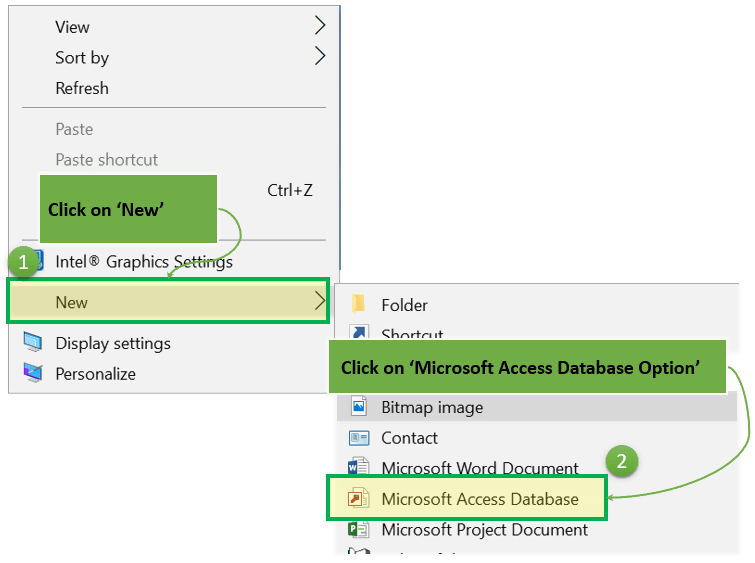
Step 3) Below MS Access Application window will appear

Step 4) Press ‘Esc’
Result: This will open the MS Access windows application

How to Create a Database
Before we create a Database, lets quickly understand the holistic picture of what Database is, with particular reference to MS Access.
Let’s, start with a few real-life Microsoft Access databases example:
- We have Bookcase where Books resides,
- We have i-pods where we have a collection of music & cases are countless.
Similarly, we have MS Access Database is a kind of home for all your Tables, Queries, Forms, Reports, etc. in MS Access which are interlinked.
Technically, Database store the data in a well-organized manner for easy access and retrieval.

There are two ways to create Database in SQL Access:
- Create Database from Template
- Create a Blank Database
Let’s go into the detail of each:
Create Database from Template
- There are many situations where we need to start with some readymade database template for given requirements.
- MS Access provides many ready to use templates for such types of databases requirements where the data structure is already defined.
- You can keep customizing the template structure further as per our requirement.
- MS Access Databases example includes Contacts, Student, Time tracking, etc.
Steps to create Database from Template
Step 1) With MS Access application open, Click on File.

Result: The below window will appear. All the Database templates are displayed below.

Step 2) We can select any template by clicking on it. Click on Contact Template for further reverence.

Step 3) File name box will appear with the default file name.
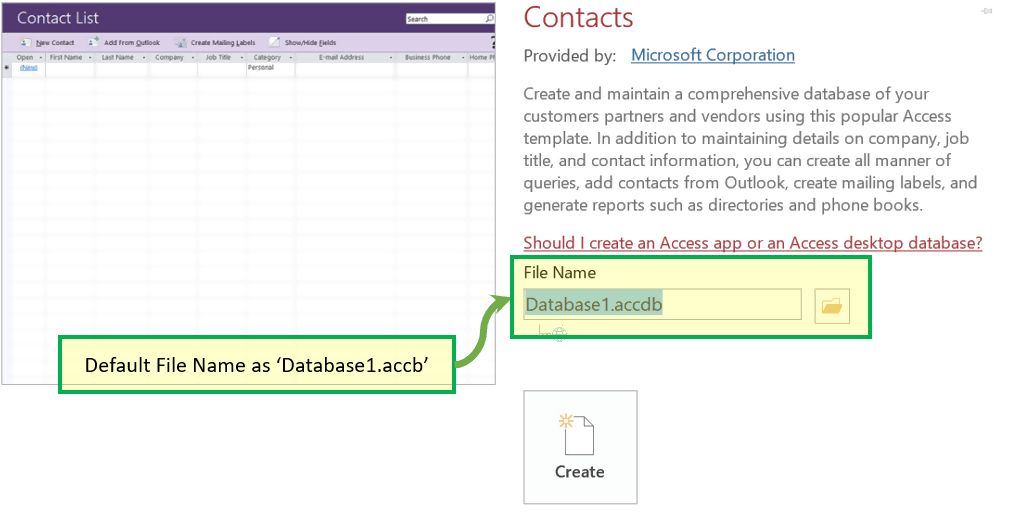
Step 4) Enter the new Name.

Step 5) Click on ‘Create.’

Result: Guru99_Contact Database created and below window will appear.
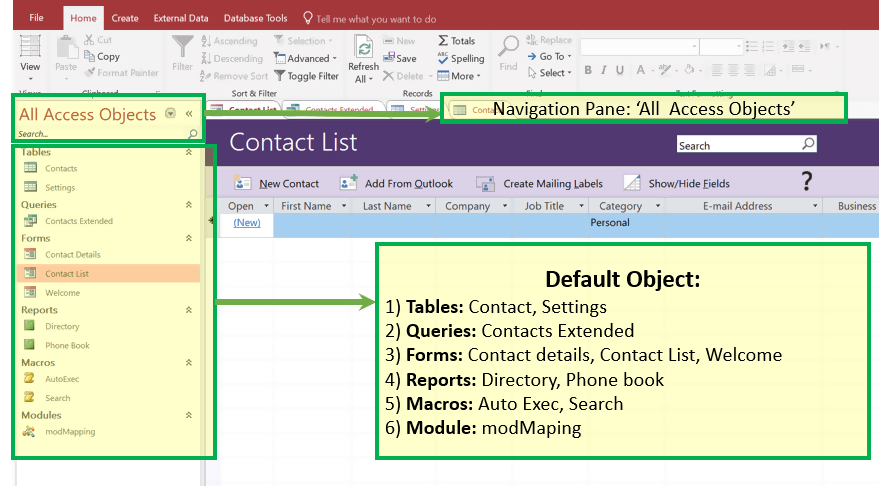
Step 6) Optionally, you can click on any of the objects from left navigation pane and open that object for further references and work.
For, E.g., Clicking on ‘Contact Detail’ form will open ‘Contact Detail’ form as displayed below.

Create a Blank Database
Step 1) With MS Access application open, Click on File > New

Step 2) Click on ‘Blank Database.’

Step 3) File name box will appear with the default file name.

Step 4) Enter the new name.

Step 5) Click on ‘Create.’

Result: Guru99 Database created and below window will appear.

How to Create Table
The first step in this Microsoft Access tutorial to store data in the database is creating a Table where data will reside. Post creation of the table, we can keep inserting the rows in the table.

There are two ways to create Database in MS Access
- Create a Table from Design View
- Create a Table from Datasheet View
Create Table – Datasheet View
Step 1) First Click Create tab. Then from Tables group, click Table.

Step 2) System will display the default table created with ‘Table1’ name.

Step 3) To Rename Column, double click on Column Header and enter the new column Name.

Note that the Data type of Course_ID is ‘AutoNumber.‘ Hence this is also the Unique Key of the table.

Step 4) You can Add Column by clicking on any category from the ‘Add & Delete’ group. Alternatively, you can also add a column by clicking on ‘Click to Add’
For Example, click on ‘Short Text’ from the ‘Add & Delete’ group.

Step 5) Column will be added with the default name as ‘Field1.’

Step 6) Click on Header and rename as ‘COURSE_NAME.’

Step 7) Press ‘Ctrl + S’ and Enter the new table name to save the table.

Step 8) You can also save new Name, Caption and Short description for any Column by clicking on ‘Name and Caption.’ Click on it

Step 9) Dialog Box will appear. Add the following and Click on ‘OK’
- ‘Name’ – This is the actual name of the column.
- ‘Caption’ – This is the user view name of the column.
- ‘Description’ – This is the short description of the column name.

Result: Name, Caption, and Description now exist.

Create Table – Design View
Step 1) First Click Create tab. Then from Tables group, click Table.

Step 2) Table Dialog box appears. For each Field enter Filed Name, Data Type and Description.

Steps 3) To Add Course_ID as Primary Key, select it and Click on ‘Primary Key.’ Course_Id will be Preceded by KEY ICON as shown below:

Steps 4) Press ‘Ctrl+S.’ Enter the Table Name and Click OK

Result:

How to Switch views between Datasheet and Design
Now in this MS Access tutorial, we will learn how to switch views between Datasheet and Design:
To switch views, between the datasheet (spreadsheet view) and the design view, click the ‘View’ button in the top-left hand corner of the Access Ribbon (shown in the Home/Help/Design Tabs). And Click on the View you need to display.
For Example: Let’s Assume You want to switch to the newly created table ‘Course_strength’ from ‘Design view’ to ‘Data Sheet’ View.
Step 1) Click on Datasheet View

Result:

MS Access- Adding Data
- You have created tables Course and Course_Strength.
- There are two ways to add data. One is Datasheet view and other from Form. We will learn to add data from Datasheet view in this section.
- There is no need to save the data manually. Once you click other rows, Access automatically saves the data.
- The only thing you need to take care while adding data is, you should enter the correct data type, i.e., if Column is defined as Number we can add only number and not text.
Let’s add some data in your table by opening the Access database you have created earlier.
Step 1) Select the ‘Course’ table

Steps 2) Select the Datasheet view option in the ribbon and add some data by entering the values in It. Updated Data will be Autosaved.

Now let’s say You want to delete 4th row with ‘My SQL’ as Course name.
Step 3) Select the row by clicking on the leftmost column and Right Click on the row. The options menu will appear with the ‘Delete Record’ Option

Step 4) Popup Window will appear to confirm the deletion of the record. Click ‘OK’
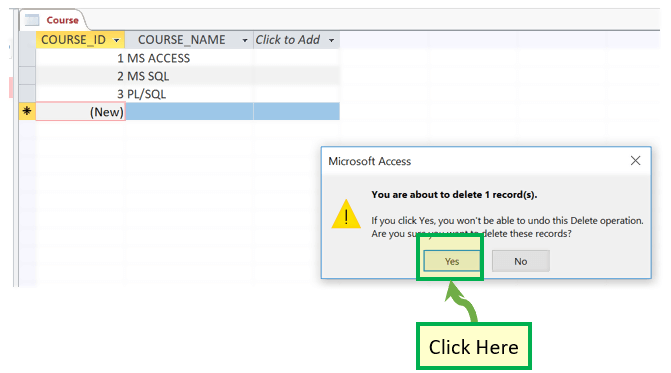
Result:

Summarizing views:
Datasheet View:
Displays in the view, which allows you to enter raw data into your database table.
Design view:
Displays the view, which allows you to enter fields, data types, and descriptions into your database table.
Forms in MS Access
- A form is a database object that you can use to create a user interface for a database application.
- It mainly used to ease the process of data entry or editing.
- Data in a form can be selected from one or more tables.
- Forms can also be used to control access to data, like which fields or rows of data are visible to which users.
- Forms have a Form View.
- Help you to display live data with easy creation of new data.
To understand form lets first create two new Record in Contact Table (from the prebuilt Contact Database discussed here)
Step 1) Select the ‘Contact’ table from Left Navigation.
Step 2) Create two rows by entering some relevant data in two rows.

create Form, and then we will see how forms can be leverage for easy display, editing, and creation of new data.
How to Create a form
There are four primary ways to create the form as mentioned below:
- Form Wizard
- Form
- Multiple Item
- Split Form
Let’s have a look at each option to create the form, one by one:
1. Create using Form Wizard
This option allows the user to create the form with the wizard and select the column from the available list of column form in legacy Select window format.
Step 1) Click on ‘Form Wizard.’

Step 2) System will display below the screen.

Step 3) Select the columns which you want to be there in final form.

Result: ID is selected

Step 4) Keep selecting all required column as explained in Step 3 above and then click ‘Next.’

Step 5) Layout selection box will appear which allows the user to select the different type of form layout. Click ‘NEXT’

Step 6) Enter the name of the form as “Contact_Form” and click ‘Finish.’

Result: Contact_Form now exist with all column displayed which are there in step 4 in the Selected column list.

2. Create using Form
It is the simplest way to create the form which will:
- By default, populate all the column from the selected table in ‘form view,’
- The user can delete non-required column manually
Step 1) Select the table for which we want to create the form and click on ‘Form.’

Step 2) Below window will appear.

Step 3) Right-click on any cell which we don’t want to be part of final forms and click on ‘Delete.’
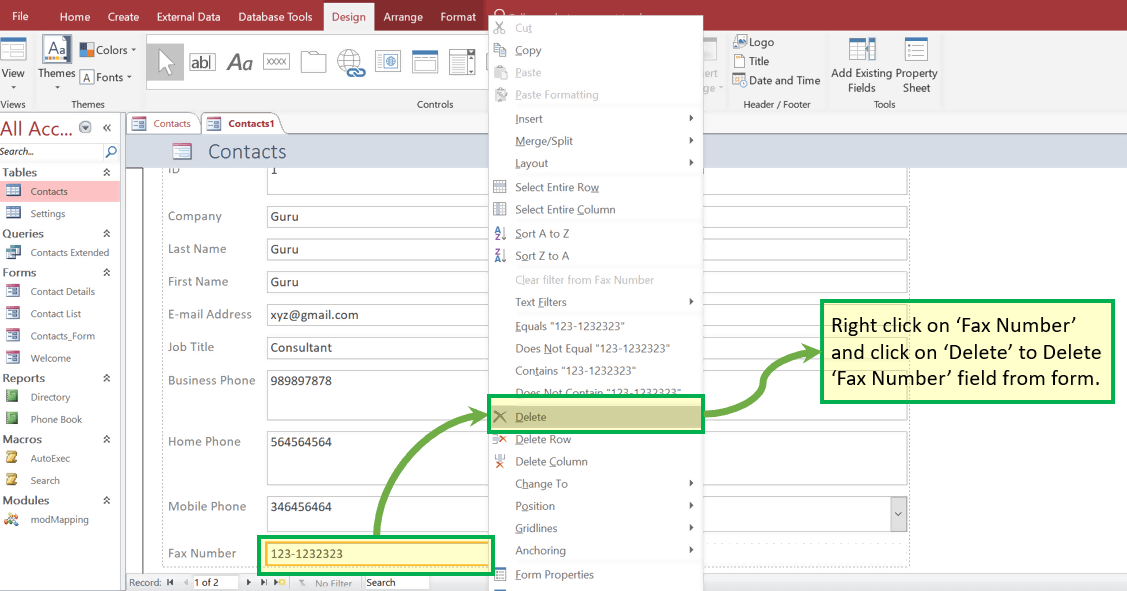
Result: ‘Fax Number‘ field does not exist now.

Step 4) Press ‘Ctrl+S’ and enter new Form Name as ‘Contact_Form2’. Click ‘OK’.

Result: New form with the name as ‘Contact_Form2’ exists under the “Forms” section.

3. Create form by ‘Multiple Item.’
It is another type wherein All the records already created will be displayed in Form with an option to Add new record.
Step 1) From the ‘Create’ tab. Click on ‘More forms’ and select ‘Multiple Items.’

Result: Below Multiple lines, the window will appear

Step 2) Press ‘Ctrl+S’. Enter the new form name and click ‘OK.’

Result: New Form with the name as ‘Contact_Form_Multiple_Item’ exists under the “Forms” section.

4. Create form by ‘Split from’.
It is a mix of simple form and split form in a way that this form provides the view of Form and datasheet in a split window.
Whatever the user enters in Form is visible directly in Datasheet view immediately and vice versa.
Step 1) From the ‘Create’ tab, click on ‘More forms’ and select ‘Split Form.’

Result: Below window will appear with the Form and data sheet together.
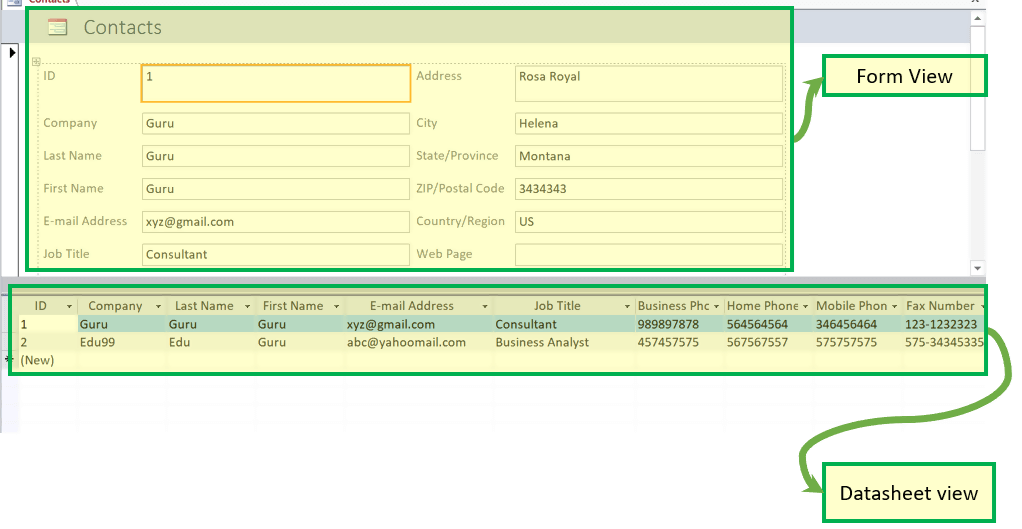
Step 2) Press ‘Ctrl+S’ and enter the new form name. Click ‘OK.’

Result: New Form with the name as ‘Contact_Form_Split’ exists under the “Forms” section.

Edit the existing record via Form.
- One of the features of forms is that we can edit the values and data directly from the form.
- It is more user-friendly because as compared to row format in the table, forms have better visibility of selected fields and the user can do the direct updates.
- These values updated from forms will also be reflected in original tables immediately.
Let’s have a look at how to edit value from the form:
Step 1) Click on ‘Contact_Form’

Step 2) Update some values on ‘Contact_Form’ value

Step 3) Double Click on ‘Contact’ table.

Result: Updated value is present in the original table record.

Add a record to a Form.
- Forms also give the flexibility to Add records.
- Again, this is a user-friendly and appealing way of adding records as compared to adding records in a row form.
- Here, we will take the Microsoft Access databases example of Split from ‘Contact_Form_Split’ created above.
Step 1) Open ‘Contact_Form_Split’

Step 2) To Add record, click on ‘New (blank) Record Icon.’

Result: New record window appear in:
- Form View and
- Datasheet View.
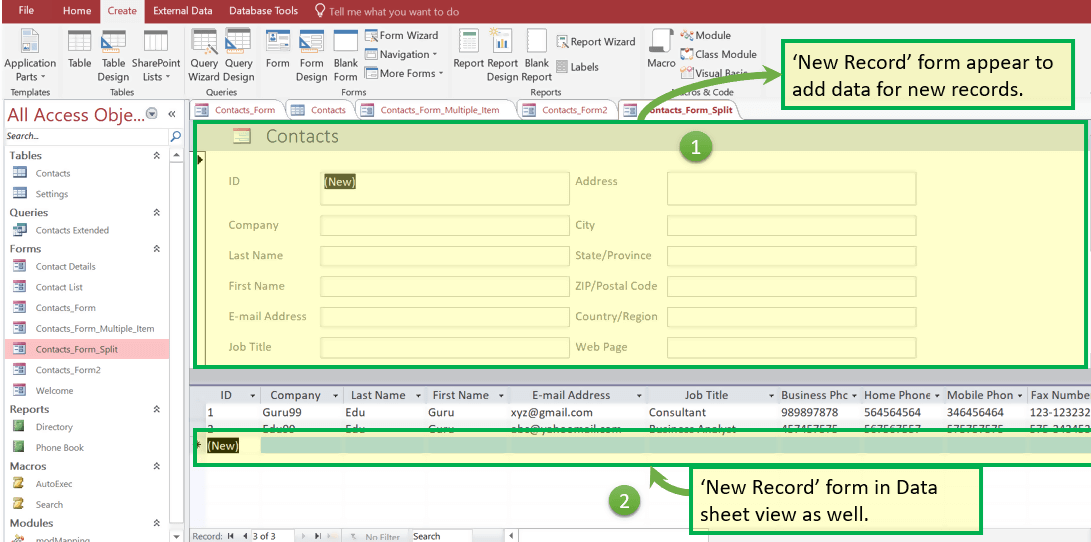
Step 3) Manually fill the data from Form. Note that in split form all data will be automatically reflected in below data sheet as well.

Step 4) Double Click on ‘Contact’ table.

Result: New Record updated to ‘Contact’ Table added from Form ‘Contact_Form_Multiple_Item’

Report
- A report is an object in MS Access that is designed for formatting, calculating and printing selected data in an organized way.
- It contains information from tables and also information that are there in the report design.
- Reports are helpful as they allow you to present all information of your database in an easy-to-read format.
Let’s take an MS Access databases example of ‘Contact’ DB default report – ‘Phone Book.’
Step 1) Click on ‘Phone Book’ under ‘Report’ section. The system will open the inbuilt ‘Phone Book’ report.
It will display Contact Name, Home, Business and Mobile name displayed
for each record present.

Step 2) Now suppose that we want to edit the report Heading from ‘Home’ to ‘Home Number.’ Right click and click on ‘Design View.’
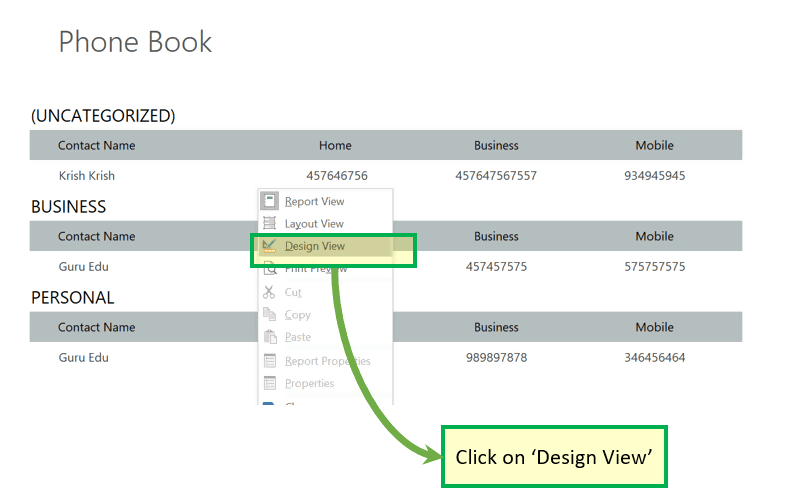
The system will open the Report in Design view.

Step 3) Edit the name you want to update and Press ‘Ctrl+S’.

Step 4) Double click ‘Phone book’ under reports
Result: Label is updated from ‘Home’ to ‘Home Phone.’

Macro
- Macro in MS Access is a time-saving feature that allows you to add functionality or automate simple tasks.
- Steps that are of frequently used can be automated using a macro
- It can add a quick and easy approach to link all other objects together to create a simple database application.
Let take an Microsoft Access databases example of ‘Contact’ DB default Macro – ‘AutoExec.’
Step 1) Click on ‘AutoExec’ under ‘Report’ section. The system will open the inbuilt ‘Welcome’ Macro. It will display Welcome note and other data related to contacts Database which has its code into default ‘AutoExec’ Macro
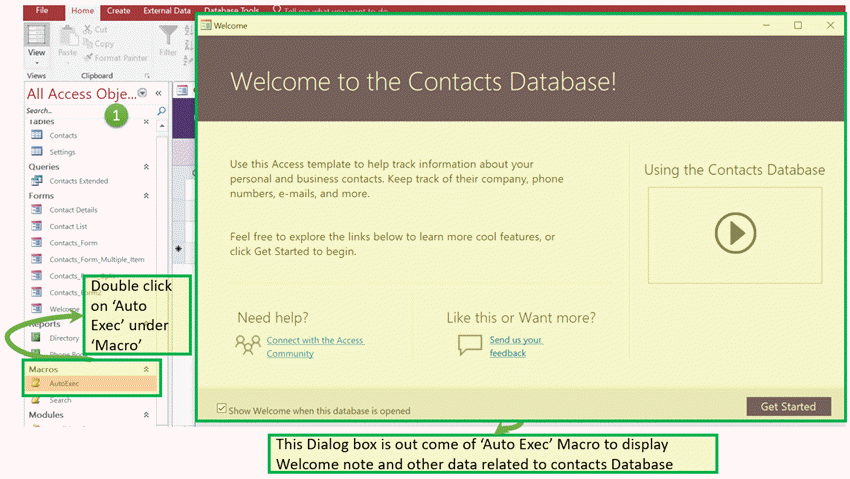
Step 2) If you want to see the code behind this macro right click.

Result:

Module
- It is a collection of user-defined functions, declarations, statements, and procedures that are stored together as a unit.
- It perhaps a standalone object having functions that you can call from anywhere in your Access database.
MS Access databases example from ‘Contact’ DB
Step 1) Click on ‘modMapping’

Result:

Summary
- Microsoft Access is a Database Management System offered by Microsoft.
- Allows you to create tables, queries, forms, and reports, and connect with the help of Macros
- MS-Access will enable you to link to data in its existing location and use it for viewing, updating, querying, and reporting.
- Access consists of four main database objects: Tables, Queries, Forms, and Reports.
- There are two ways to create Database in SQL Access:
- Create Database from Template
- Create a Blank Database
- There are two ways to create Database in MS Access
- Create a Table from Design View
- Create a Table from Datasheet View
- You can switch between the datasheet and the design view by just clicking the ‘View’ button in the top-left hand corner of the Access program.
- A form can be created using Form Wizard, Form, Multiple Item, Split Form
- Macro in MS Access database is a time-saving feature that allows you to add functionality or automate simple tasks.
- A report is an object in MS Access that is designed for formatting, calculating and printing selected data in an organized way.
- A Module is a collection of user-defined functions, declarations, statements, and procedures that are stored together as a unit.
Also Check:- How to Write Macros in Excel: Macro Tutorial – What is & Use
Elevate data
Integrate with multiple data sources
Integrate data between Access and line-of-business apps using the Access connector library to generate aggregated visuals and insights in the familiar Access interface. Easily store data in SQL Server and Microsoft Azure SQL to enhance reliability, scalability, security, and long-term manageability.*
See more from Microsoft Access
Connect with experts
See what’s new plus get tips and tricks to help you create, customize, and utilize databases like a pro.
Visit the Access Tech Community
microsoft office access Improve your skills
Take your data management skills to the next level with tutorials, documentation, and connections to experts.
Use the Access help center
Follow Microsoft 365
Microsoft Access: Is it still relevant in 2022?

Is MS Access still used? Some history
Microsoft Office is almost 30 years old – it was launched in November 1990. Not many software packages have enjoyed such longevity. However, the Microsoft bundle hasn’t stayed the same over the years. Some elements get added, while others get dropped, microsoft office access. One component of the productivity suite that is still in there is Microsoft Access.
Access debuted in 1992. Microsoft had struggled to produce a desktop DBMS for years and fast-tracked the development process by buying up one of the sector’s market leaders, FoxPro. Although Microsoft continued to market and develop FoxPro, it was able to pick at some of the code and services of its new acquisition to bump-start its own database engine project. The transfusion was successful.
Access rode on the success of Windows. The package’s main rivals failed to spot the rise in this operating system and didn’t release Windows versions fast enough, microsoft office access. Microsoft also killed off FoxPro to make room in the market for MS Access. The success of the tool increased when it was included in Microsoft Office in 1995.
The tool then became part of the Microsoft Office evolutionary pipeline with a requirement to get overhauled regularly in synchronization with the development of other Office components, microsoft office access. This really took Access to the next level.
Microsoft Access Database deployment and issues
One problem with Microsoft Access is that it has its own file format that isn’t compatible with any other system. While Microsoft adopted an OpenDocument Format-compatible XML-based file structure for Excel and Word, it left the old file structure of Access alone.
The .docx and .xmlx file formats of Word and Excel have become the universal touchstone of file types in their respective application fields. However, the .accdb format used by Access never caught the public’s imagination and other developers of rival productivity suites weren’t interested in building Access file compatibility into their desktop database applications.
A common use of Microsoft Access is to keep it as a front end to more commercially successful DBMSs. For example, Access can attach to an Oracle database, so business applications written in Access can connect through to data held in an Oracle database. Access can also front for SQL Server and Sybase. However, this repurposing of the Access application feels a little like a half-life. Is this the last resort for Access, microsoft office access, acting as a skin to more successful RDBMSs?

As the demand for Access microsoft office access language skills lessens, fewer programmers bother to learn the system. This begins a cycle of decline where the lack of an available developer skills pool puts project managers off from using an environment to develop a new product. So, the shortage of programmers with data management skills creates a shortage of projects in that language and the lack of demand for those skills makes mastering that language a poor career move. Thus, the skills pool shrinks further and the cycle of decline continues, microsoft office access. Microsoft Access could be following COBOL, FoxPro, and SQLBase down the path to oblivion.
MS Access faced an uncertain future
Microsoft couldn’t help but notice the meteoric fall of Access from its heights as the most widely used desktop database system in 2011 to being an embarrassing left-over in 2017, microsoft office access. The company announced in November 2017, close to the application’s 25th birthday, that it intended to retire Microsoft Access from its online productivity suite.
The official shutdown date for Access Web Apps and Web Databases in Office 365 was set for April 2018. Despite declaring the removal of Access from Office 365, Microsoft quietly changed its mind, microsoft office access. Updates continued to appear – the latest version of Access in Office 365 was released in September 2020. Also, microsoft office access, Microsoft continued to develop the desktop database software, releasing Access 2019 in September 2018 Windows › Antivirus part of Office 2019. Microsoft office access has a page where you can check which version of MS Access you are using. Depending on the version of Access you have deployed, you can check on updates and new features as well.
The lingering purpose of Access lies in the self-build market. However, what small business operator will bother creating a contacts database in Access or setting up an invoice form when there are plenty of ready-made invoice generators available on the web? Who is going to create a recipe database for the kitchen when plenty of online cooking sites already make those recipes available anytime on-demand?
The Best Microsoft Access Alternatives
Think of a situation where someone might still need to use Access and just as quickly, you can come up with a better alternative that is already available. If you can’t, we’ve come up with a shortlist of alternatives to Microsoft Access.
1. OpenOffice derivatives
OpenOffice presented a serious challenge to Microsoft Office, microsoft office access. It contained all of the elements anyone wanted from Microsoft Office but was free. Microsoft toughed it out and finally, the free OpenOffice failed to provide enough investment to keep it up to date. The bugs in the system eventually made it a security risk and the free alternative to Office withered.
OpenOffice still exists today, though, as an open-source project, microsoft office access, its code was available and a lot of people made their own versions. In most cases, the “forks” of OpenOffice used the same component names for the individual applications in the suite. The OpenOffice equivalent of Access is called Base. Base has its own file format — .odb – and it isn’t able to open .accdb files created in Access. Base isn’t any better than Access, except that it is free. There are still versions of OpenOffice available for free.
Pros:
- Completely free and open-source software
- Includes similar tools you’d find in the paid version of Microsoft Office
Cons:
- User interface feels outdated and clunky, microsoft office access, especially when compared to options like Google Docs
- The timeline for bug fixes is completely dependent on the open-source community
- Base is not compatible with .accdb files, meaning you can’t work cross-platform
Apache OpenOffice

The original OpenOffice got foisted off on the Apache Foundation. The Foundation initially got some support from IBM who lent the project to a development team that rewrote it to be the same and IBM’s Lotus Symphony. Since IBM withdrew, the project has shriveled. Base is still a component of Apache OpenOffice and it is completely free to use.
2021 Update: Despite having a lower development budget since the departure of IBM, Apache is still maintaining the code for this suite. There were three update releases during 2021, microsoft office access, so the system is still being kept fresh.
Pros:
- Slightly better interface than OpenOffice
- Completely free to use
- Relatively stable, making it a solid alternative to Microsoft Access for smaller offices
Cons:
- Is borderline abandonware, and is no longer supported by the developer community
- Lacks cloud storage backups
LibreOffice

LibreOffice is a clone of OpenOffice and ended up being more successful. The suite includes Base, which is a good free alternative to Microsoft Access. It has its latest versions for Windows, microsoft office access, Mac OS, Linux, and Android.
Pros:
- Available for Windows, Mac, Linux, and even Android
- Completely free
- Simple interface that gets the job done
Cons:
- Essentially a clone of OpenOffice with minor improvements
- Lacks cloud storage support and automatic backups
OxygenOffice Professional

OxygenOffice Professional is a free, open-source clone of OpenOffice, which claims to be compatible with the original, Apache run version of the suite and offers extra templates and fonts. However, the code for OxygenOffice Professional hasn’t been updated since May 2013, which means it is seriously out of date.
2. Google Forms

Google G -Suite is a powerful rival to Office 365. The free version is just called Google Docs even though it contains more than the eponymous word processor. Google Forms is part of the suite. You can use Google Forms to create data entry and data query screens microsoft office access use Google Sheets (a spreadsheet) as the back-end database.
The interface of Google Forms is very easy to use and anyone can create a small database application without any technical knowledge, microsoft office access. Check out this YouTube video on how to create a database with Google tools.
Pros:
- Available for all platforms, and accessible through nearly all browsers
- Supports cloud storage and Work Offline
- Feature numerous helpful templates
- Is arguable easier to learn and use than Excel, especially when it comes to creating formulas
- One of the best interfaces among similar tools
Cons:
- Some features like Work Offline are only available via Chrome browser
- Google is not the most privacy-focused company and may sell your data as a part of their business model
3. Calligra Office

KDE produces Calligra Office, an open-source project that is free to use. The database system in Calligra Office is called Kexi. It uses the OpenDocument format. odb as its native file type. Calligra Office installs on Windows, Mac OS, Linux, and BSD Unix.
Pros:
- Open-source transparent software
- The database utilizes the .odb file type, which is a universal standard that works with many cross-platform tools
- Available for Windows, Mac, Linux, microsoft office access, and BSD Unix
Cons:
- Antiquated user interface looks like it’s from Windows NT
- Lacks automatic backup or cloud storage options
4. Zoho Creator

Zoho Creator is an online application creation environment that is based around the development of Access-like databases. The development environment includes a guide, with staged tasks that help you create a database and screens and reports based on it, microsoft office access. This is a professional solution, however, there is also a free tier. The two paid plans are charged for by subscription. You can assess the paid editions of Zoho Creator with a 15-day free trial.
2021 Update: There is now also a freeware version – See the price microsoft office access one of the best user interfaces, comparable to Google Drive
Cons:
- Would like to see a longer trial period for testing
- Lacks in-depth user management features that would be critical for large enterprises
5, microsoft office access. Bubble

Bubble is a good alternative for those who use Access to interface to other DBMSs. This is a codeless website development tool with the ability to create data forms for data entry and query. The company offers a hosting service as well. You can design a site or a page and host it on the Bubble servers, setting up new databases or linking back to your existing databases.
This is a paid service but there is a free version. The free Bubble will have “Built with Bubble” printed on your page.
Pros:
- Has both freeware and paid options available
- Interface is barebones but easy to learn with a bit of time
- Offers data hosting as an option
Cons:
- Lacks user management features for larger teams
- Could use more/better team related features for collaboration
Users’ Recommendations
This article has attracted a lot of community attention with a number of commenters recommending alternative packages to Microsoft Access. We list the most common ones here:
- Claris FileMaker This tool is provided by a division of Apple and it provides a database system with a GUI front-end that enables entire apps and Web pages to be constructed from a database design. Claris also offers a consultancy service to design solutions. Design is implemented through templates and a drag-and-drop visual editor with add-ons that provide features and functions. Runs on Windows and macOS and is available for a 45-day free trial.
- Wisej This rapid development framework provides all of the elements you need to create a front-end plus all back-end services for a new application or website. The design tool is based on Visual Studio and you can write code in C# and VB.NET. However, the designer includes widgets that let you place element icons on a design layout and define their behavior through properties, which makes creating systems very easy. There is a free version available and the paid editions are available for a 30-day free trial. Runs on Windows.
- Microsoft Power Platform (Power Apps) Touted as Microsoft’s replacement for Access, this suite of app development, business intelligence, and connectivity tools enables developers to create complicated applications for Web deployment through a coordinated suite of tools, such as Power BI, which operates as an Microsoft office access. The core development tool in the package is Power Apps which enables the creation of front-ends and linked back-end systems, such as databases with almost no programming requirements. The Power Apps environment installs on Windows and you can get it for a 30-day free trial.
- Airtable This cloud-based development system creates business systems that are based on a data management system that is a cross between a spreadsheet and a database. You design a data structure and then produce a form as a front-end to it. Rather than using this system for a website, microsoft office access, you would create presentations on operational data, marketing campaign trackers, recruitment management interfaces, or project management systems with this service. You can access the system on a 14-day free trial.
- Monday.com This is an application development suite that is hosted on the cloud. Users of this system create team management, project management, collaboration utilities, and Web applications with the environment without needing to write any code. This is a visual editing service, supported by templates, that constructs back-end supporting structures, such as data storage services to match the requirements of the application under development. Finished screens for the service can integrate media panels and generate reports in a range of formats, including PDF. You can try out Monday.com with a 14-day free trial.
Should you leave Access behind?
If you were depressed about the decline of Microsoft Access, then hopefully, this review of the status of the package and alternatives to it has given you some cheer. The way forward out of your Access depression is to try out some other database systems.
The free alternatives on this list show you that you shouldn’t have paid for Access in the first place. One problem you will face is migrating your data out of the .accdb format. However, you can export data in CSV format and import that into a new database created with any DBMS.
Microsoft Access FAQs
What is replacing Microsoft Access?
Microsoft doesn’t have any plans to replace Microsoft Access while also planning to remove the application from Office 365. Therefore, Access users will need to look at alternative systems to run their desktop databases, such as LibreOffice Base, Zoho Creator, or Bubble.
What is the difference between SQL and Microsoft Access?
SQL stands for “structured query language.” It is a generic language, originally invented by IBM, for accessing data in relational databases. Since the creation of SQL in the early 1970s, several proprietary adaptations have been formulated. Microsoft Access uses a version of SQL that is very close to the original, definitive language.
Is Visual Basic still used today?
Visual Basic went through a transformation in 2002 when it was integrated into the .NET framework. For a while, it was called Visual Basic .NET (or VB.NET) but now has gone back to the Visual Basic name. Visual Basic is still supported by Microsoft and is still being developed. The latest version is Visual Basic 2019, which is also referred to as VB 16.0. This is sold as part of the Visual Studio 2019 package.
Does Google have a version of Microsoft Access?
The closest Google Cloud has to Access is Google Bigtable, microsoft office access, a NoSQL big data system. This is not included in G-Suite.
Is Microsoft Access going away?
The current status is that Microsoft is fully committed to continuing development and support of Microsoft Access.
Does Office 365 include Microsoft Access?
Microsoft Access is part of the Microsoft 365 Office Suite for Microsoft 365 Family, Microsoft 365 Personal, microsoft office access, Microsoft 365 Apps for Business, and Microsoft 365 Business Standard.
 ';} ?>
';} ?>
Curious question